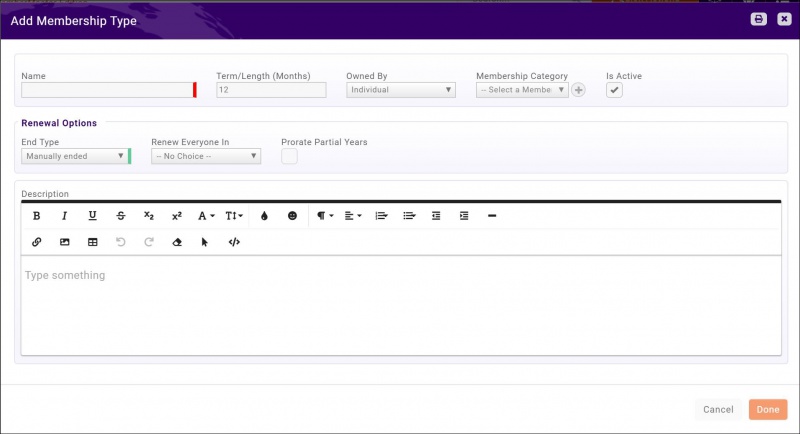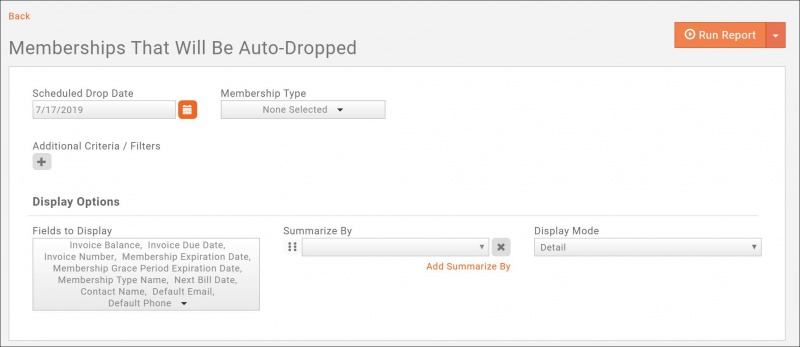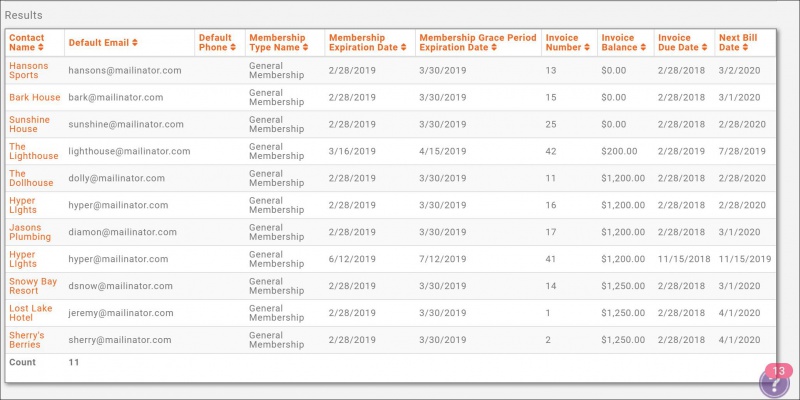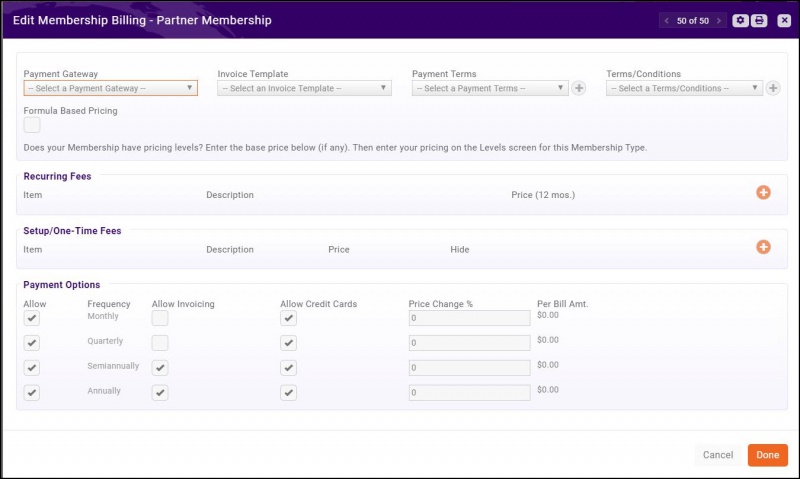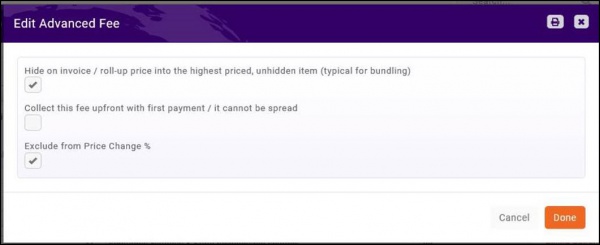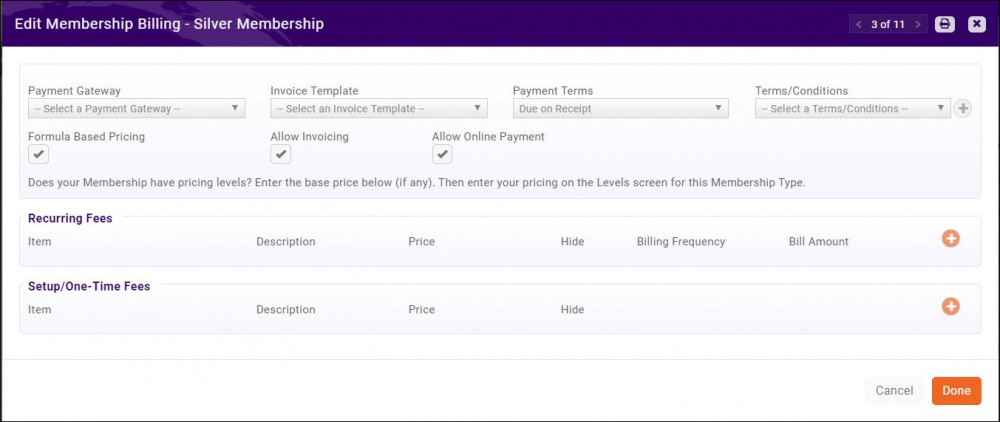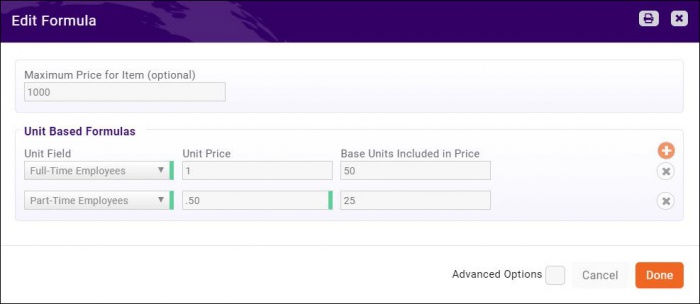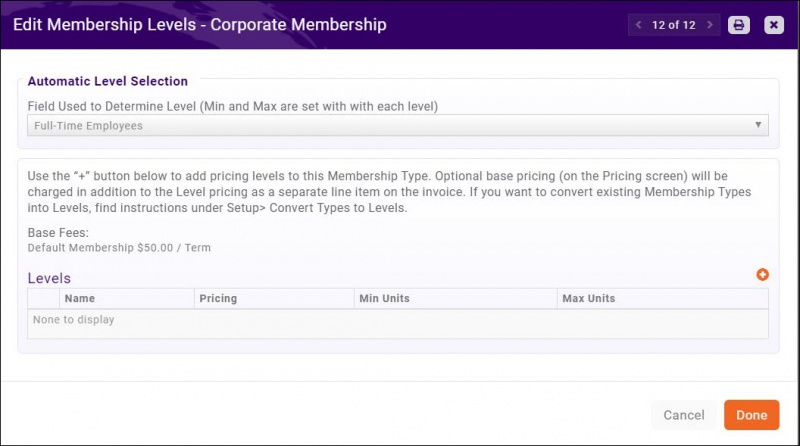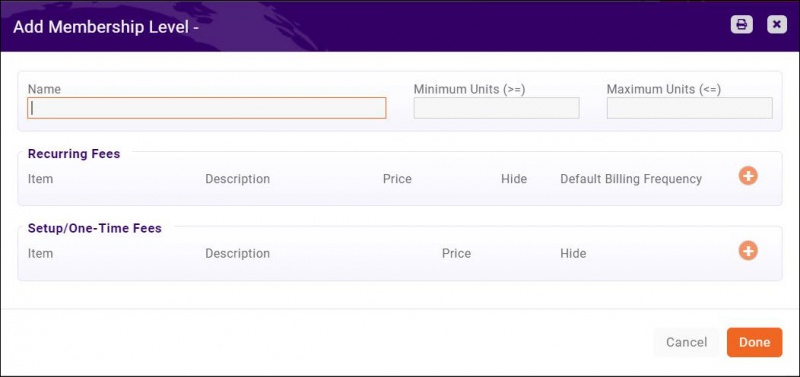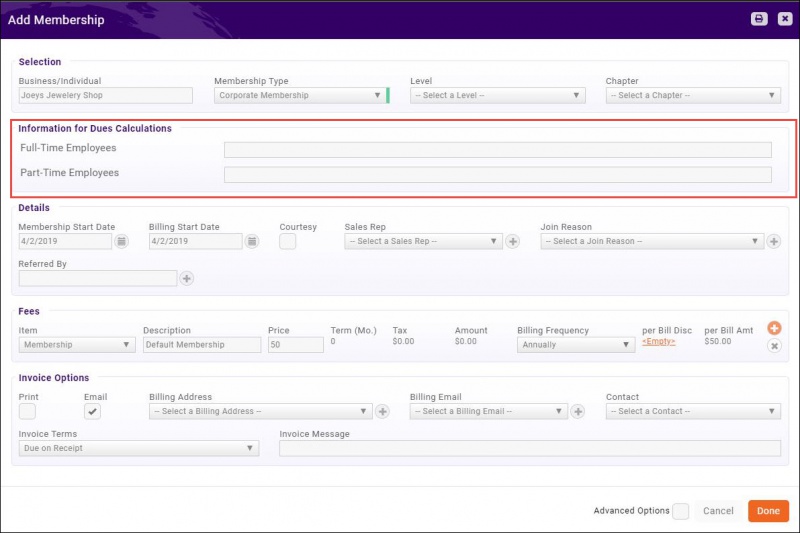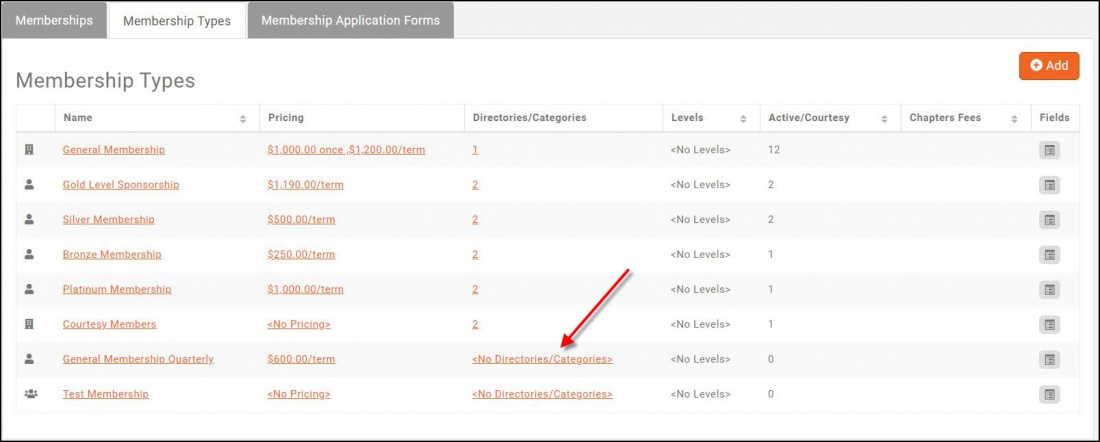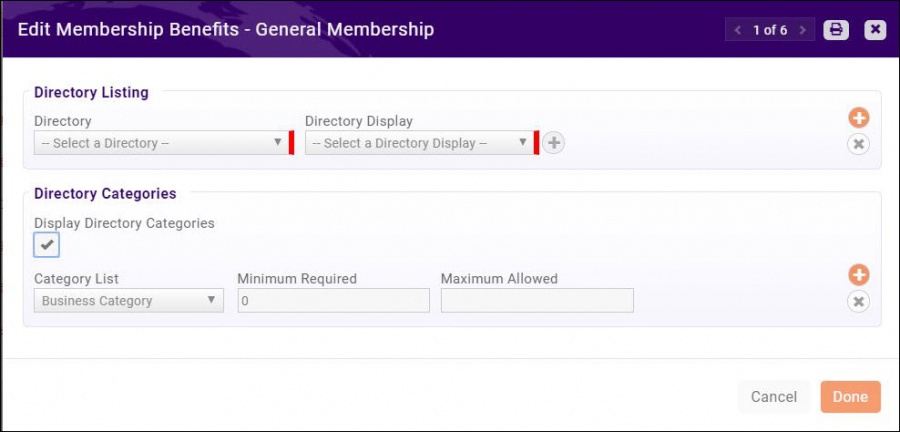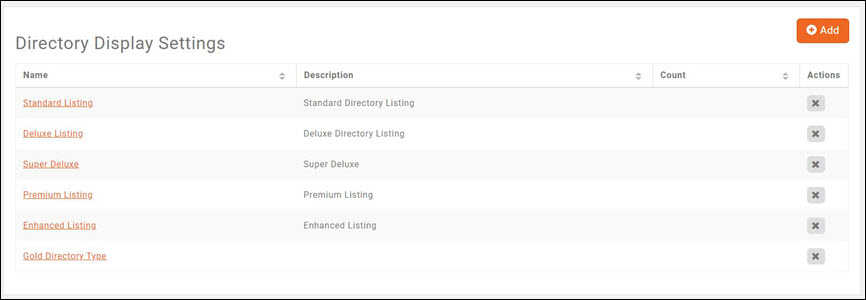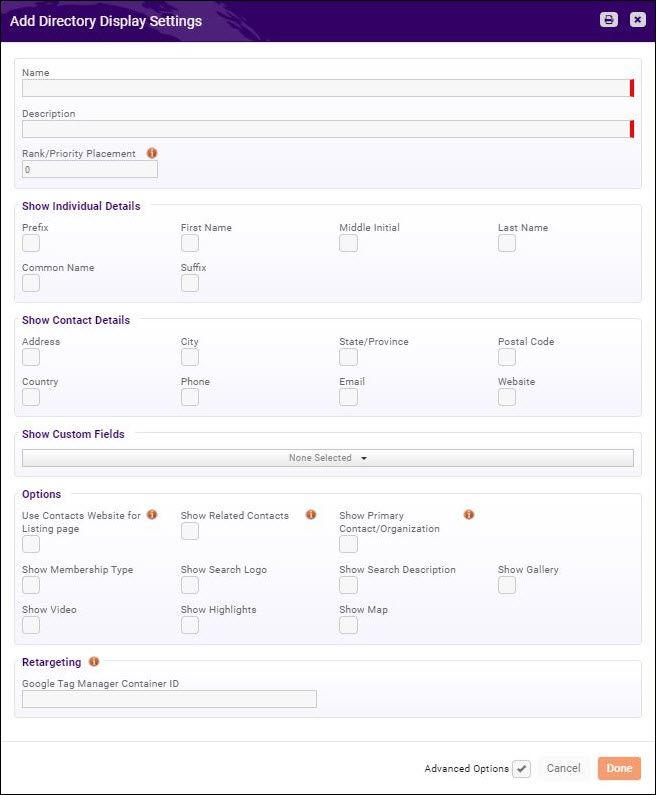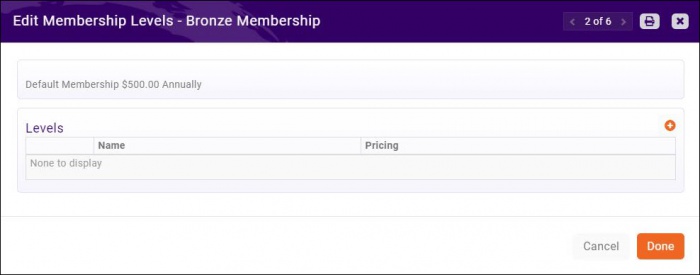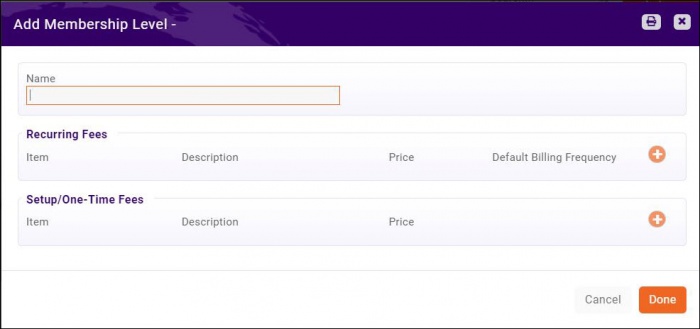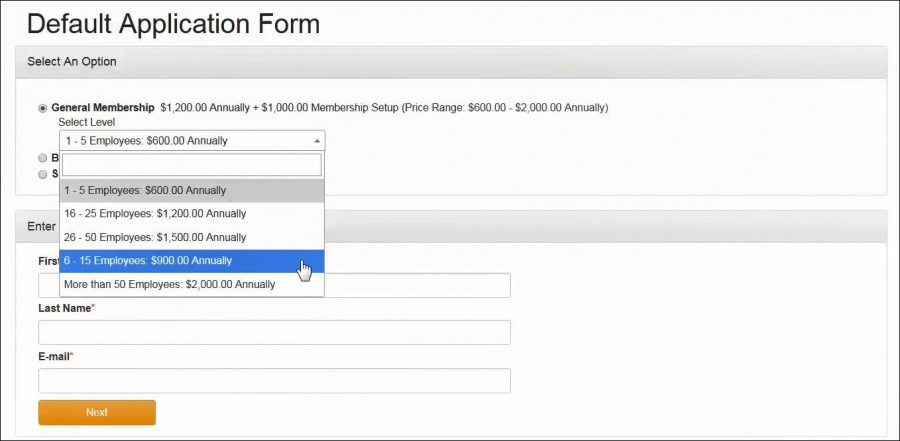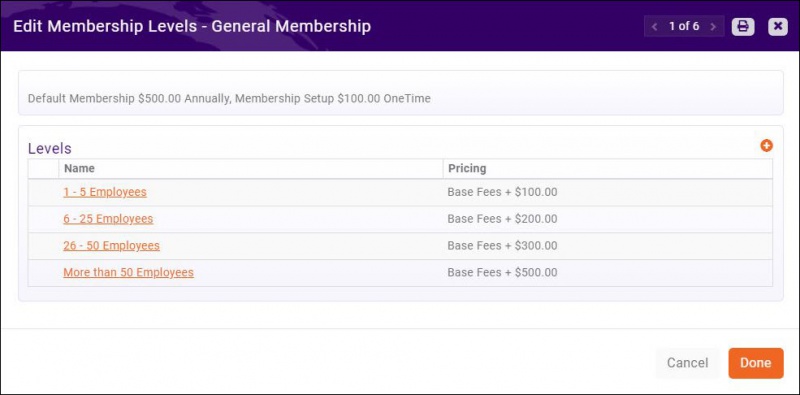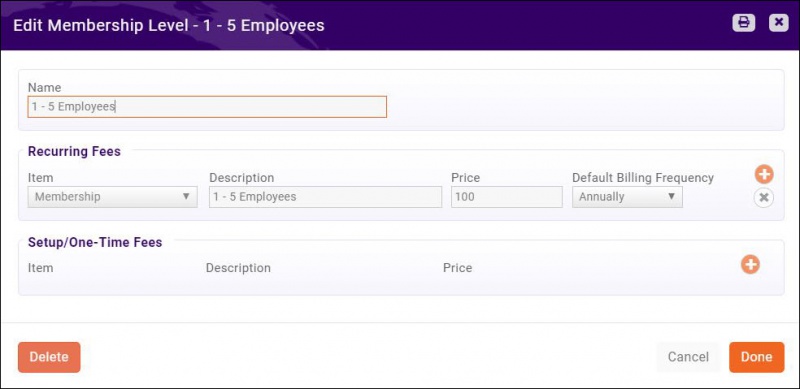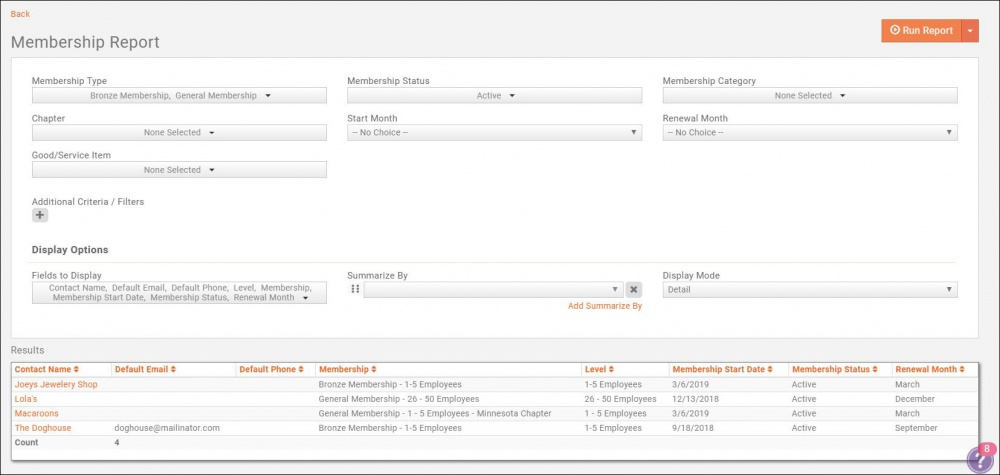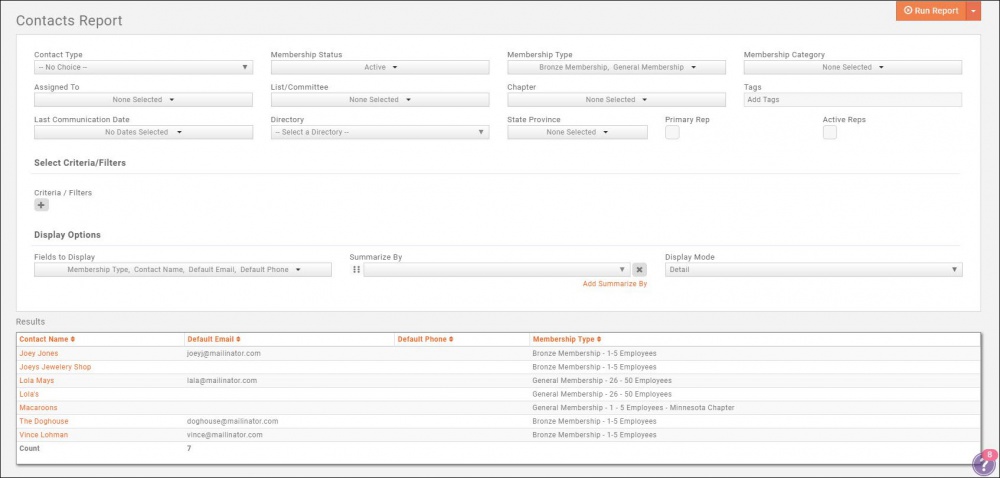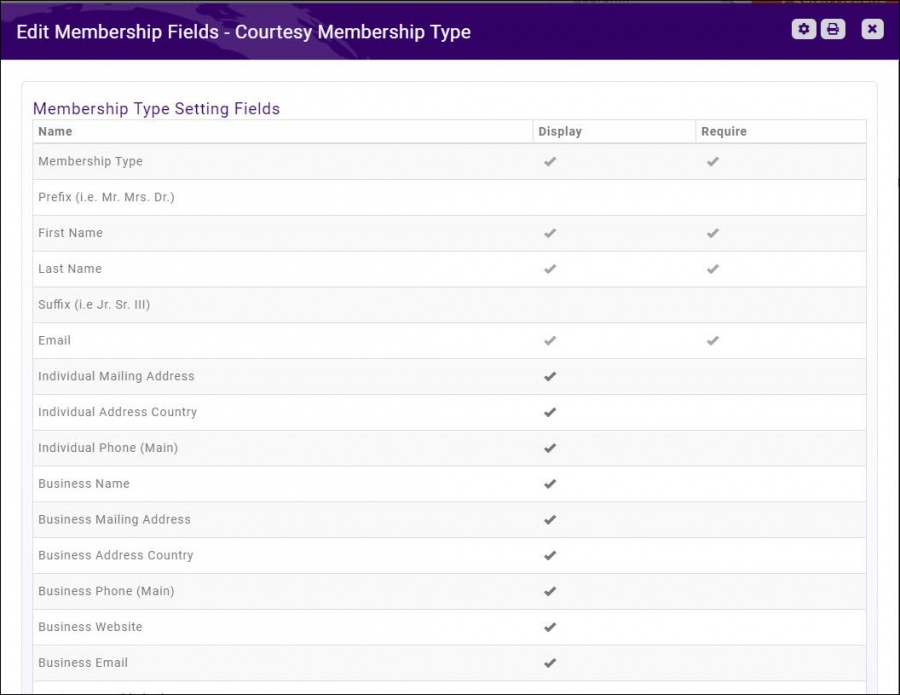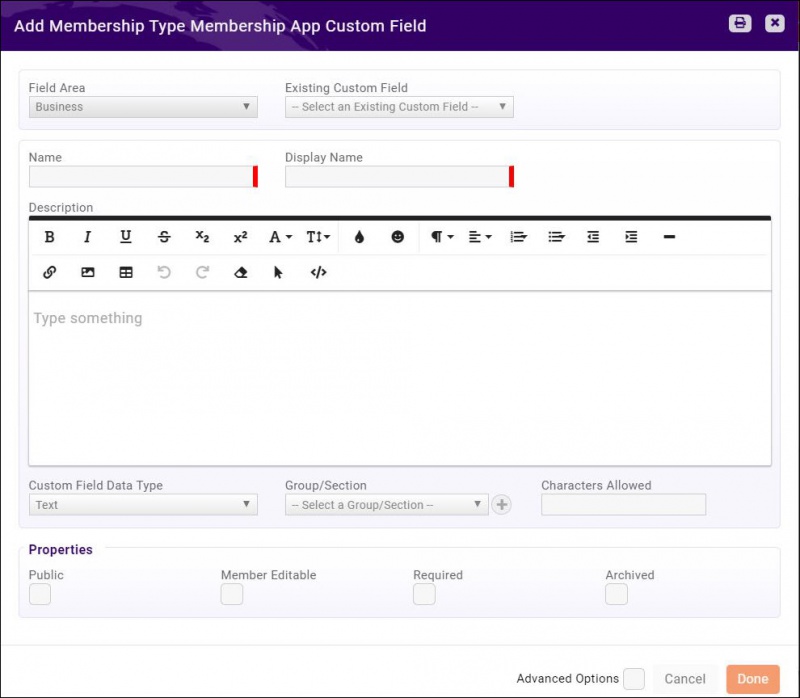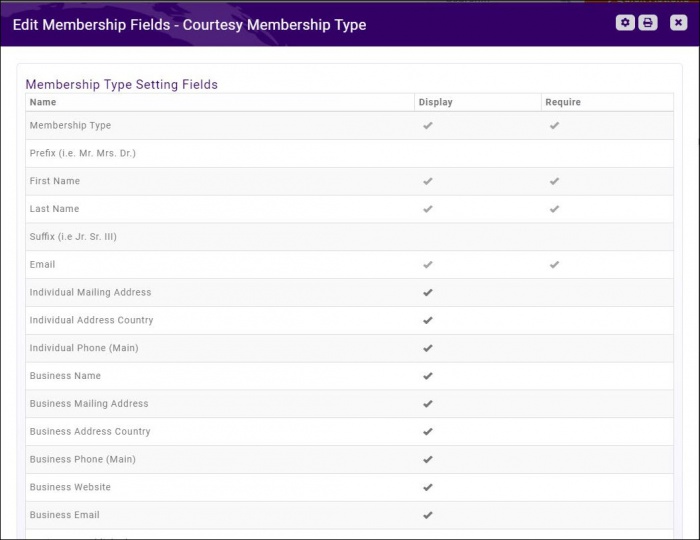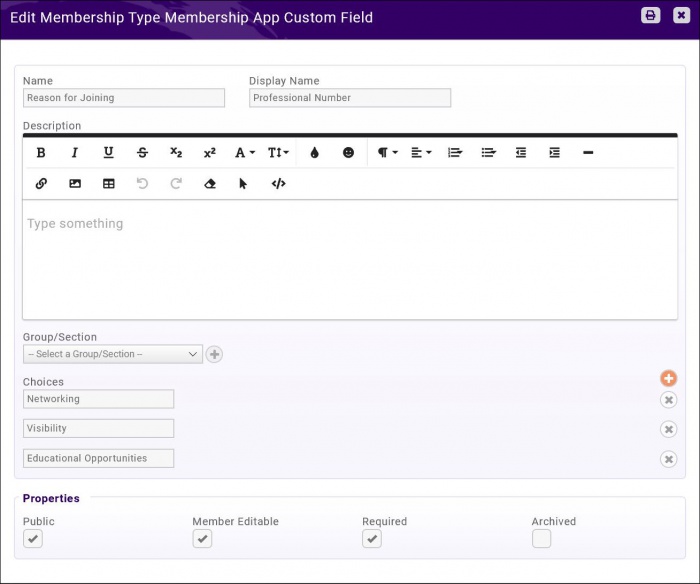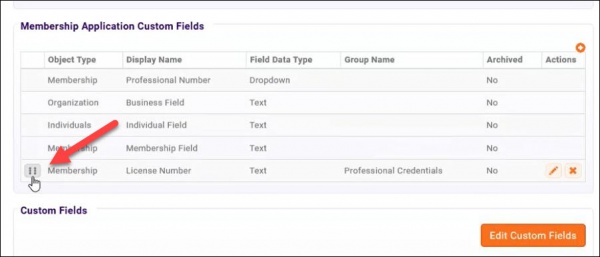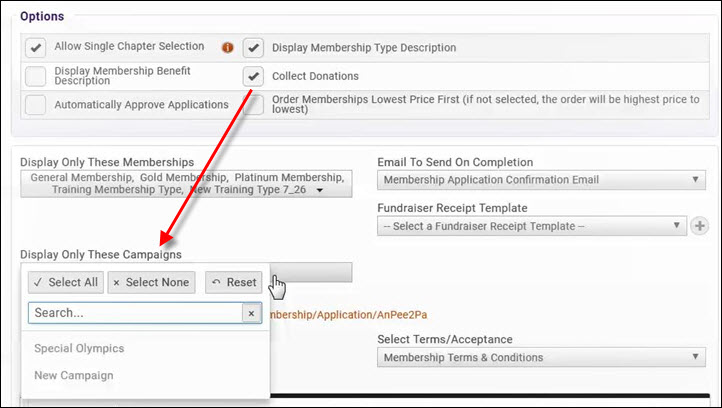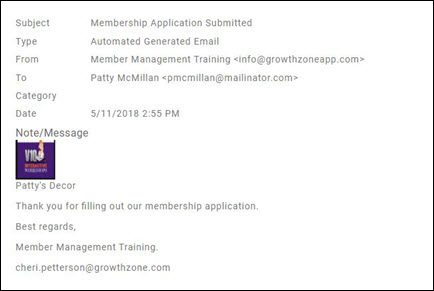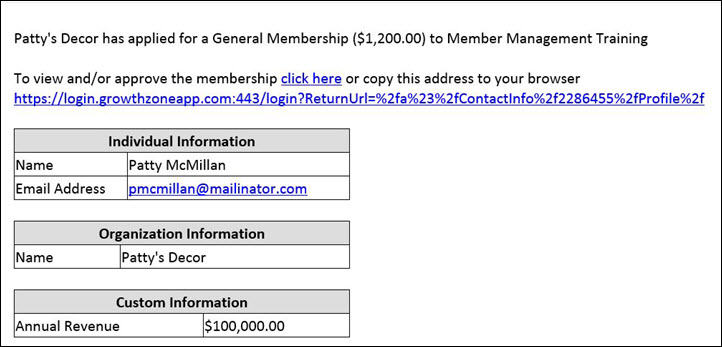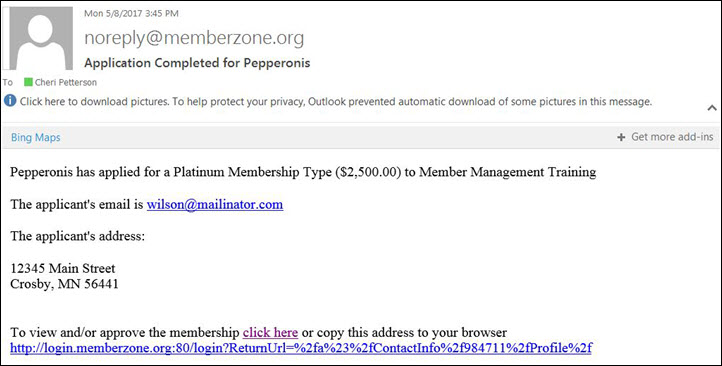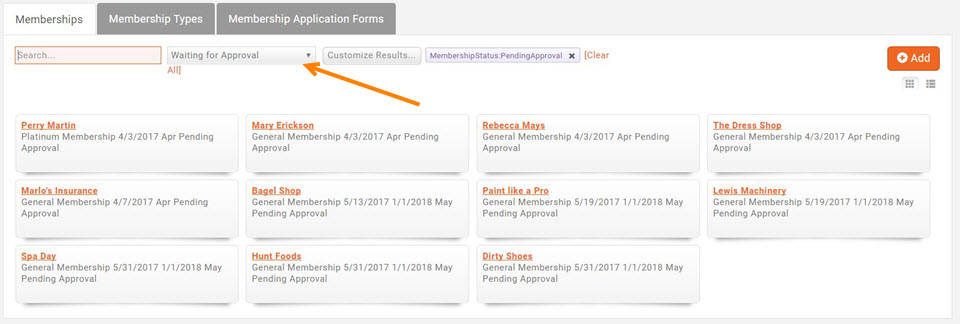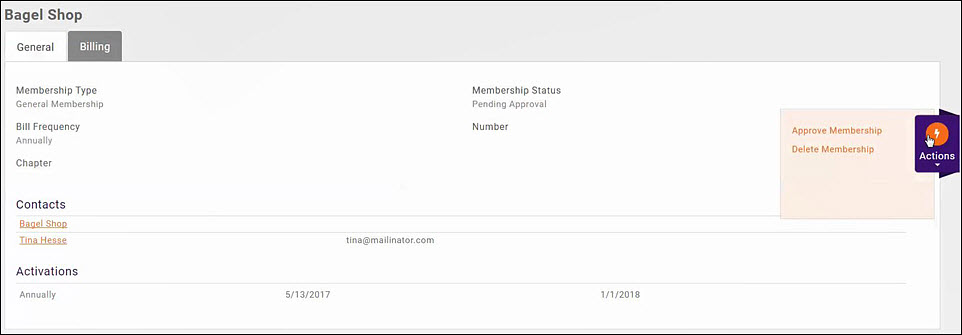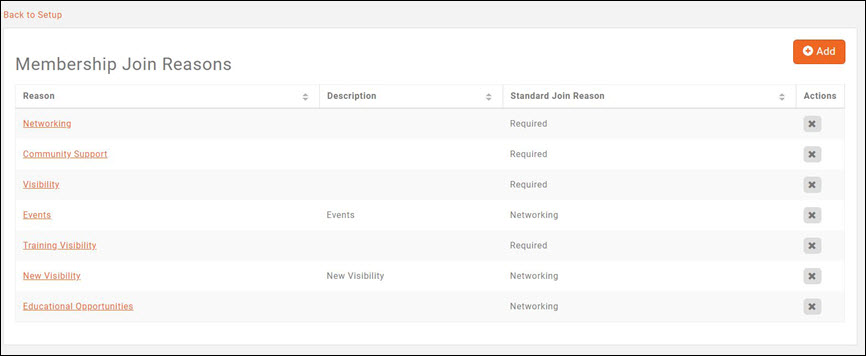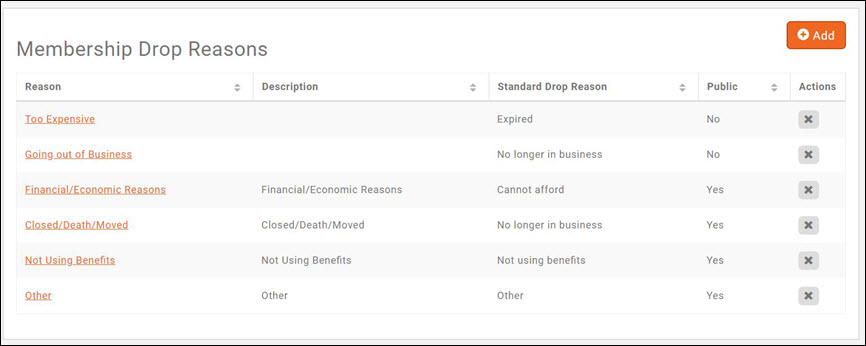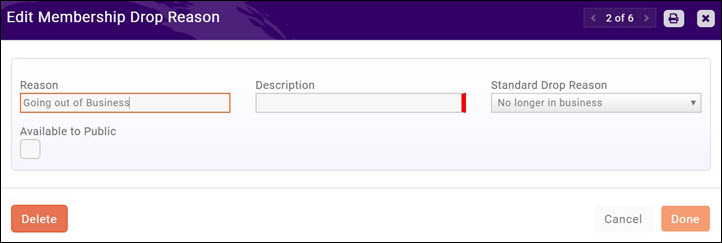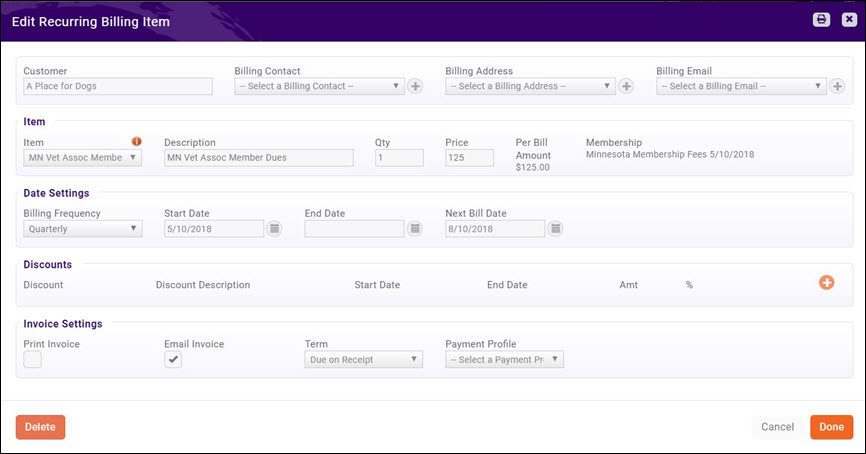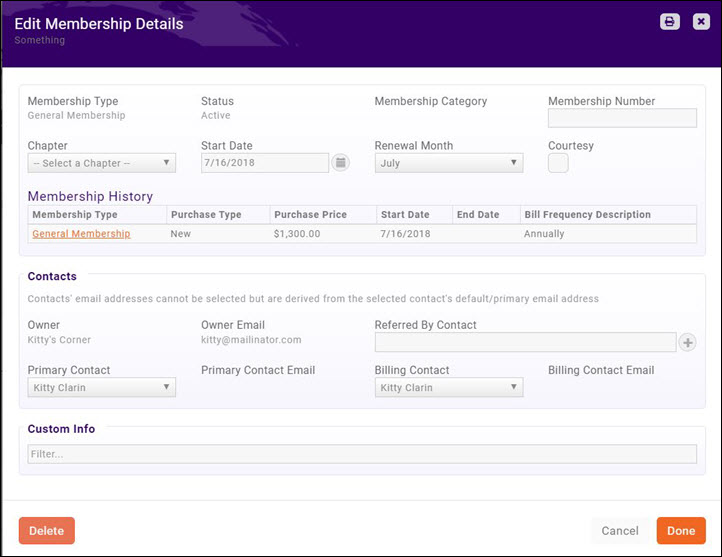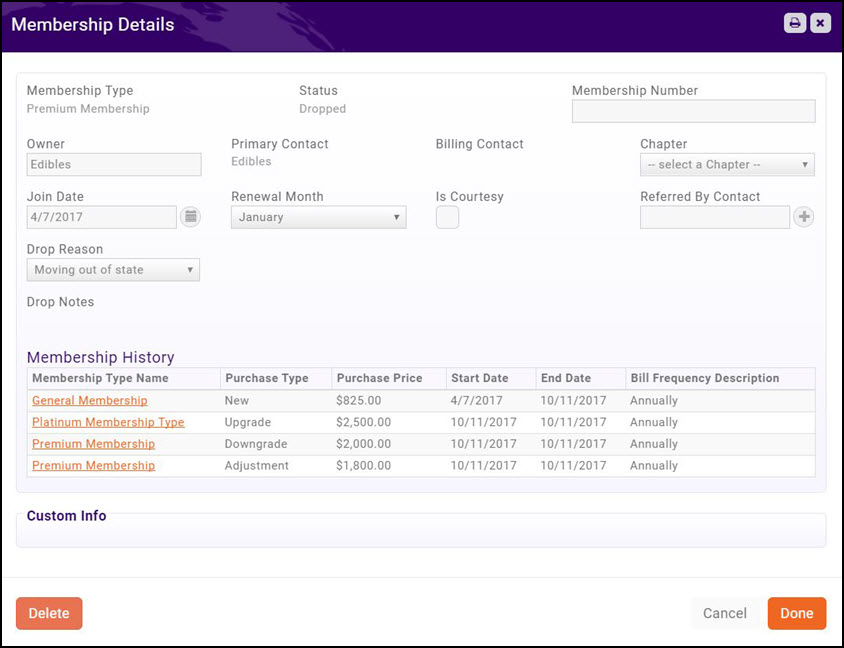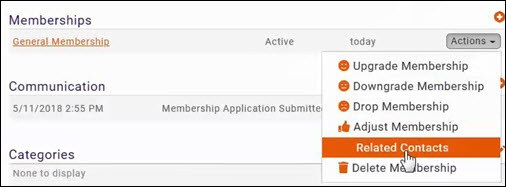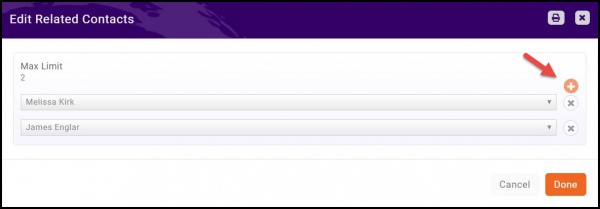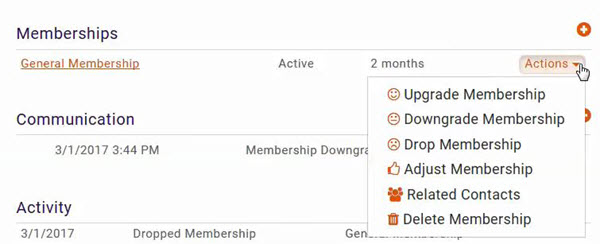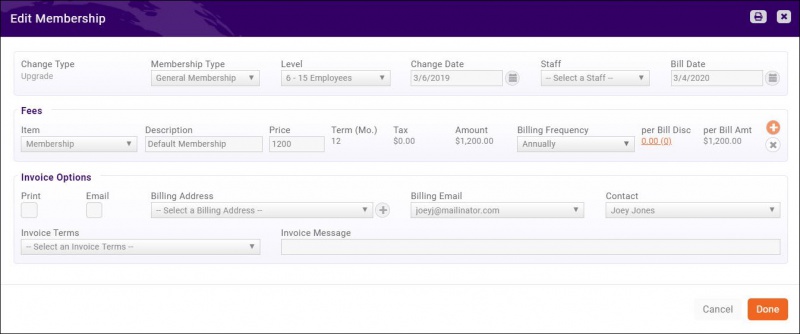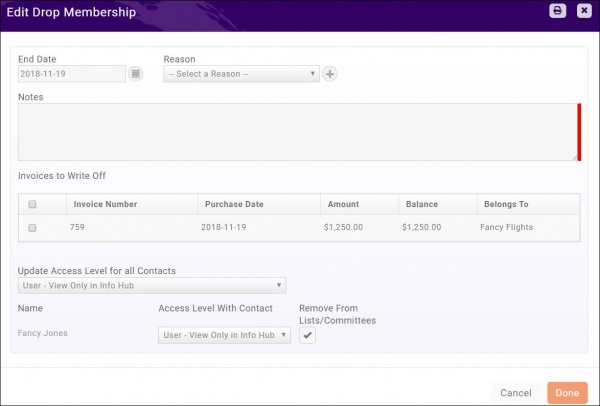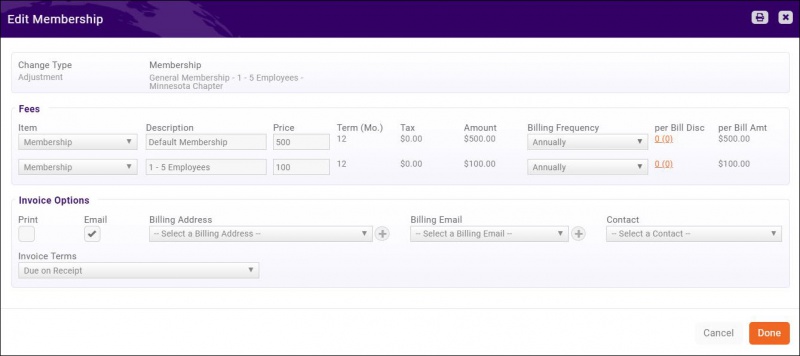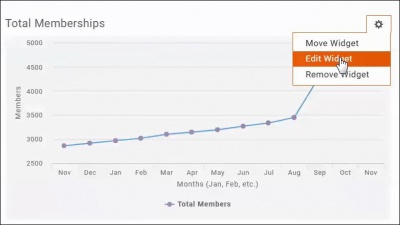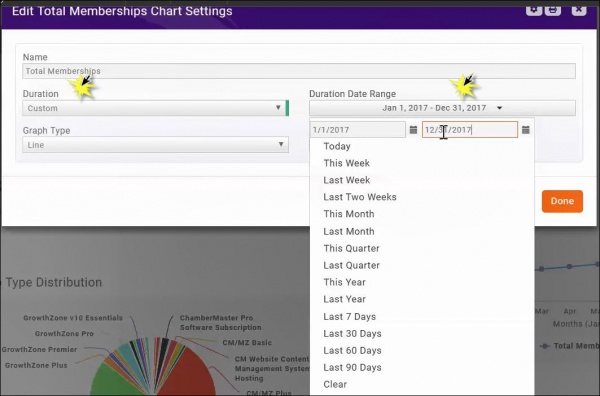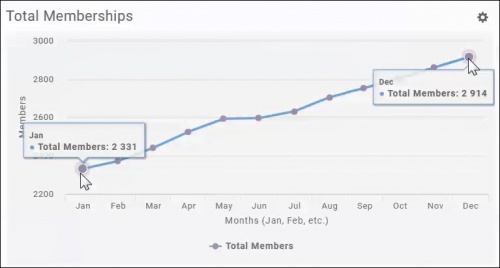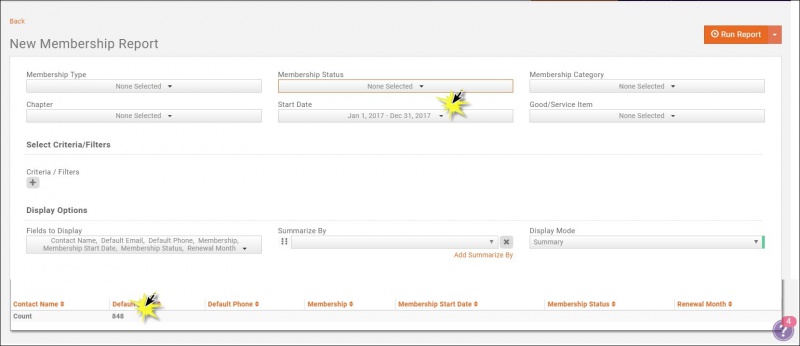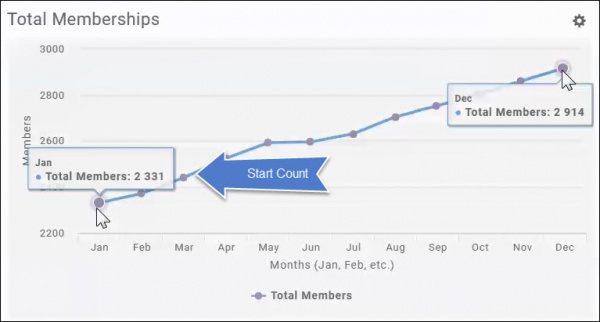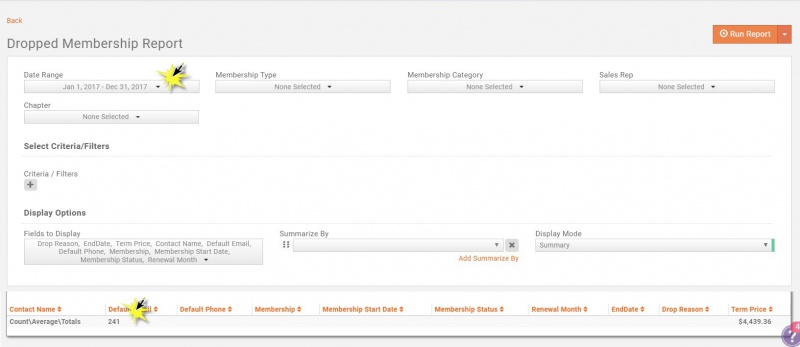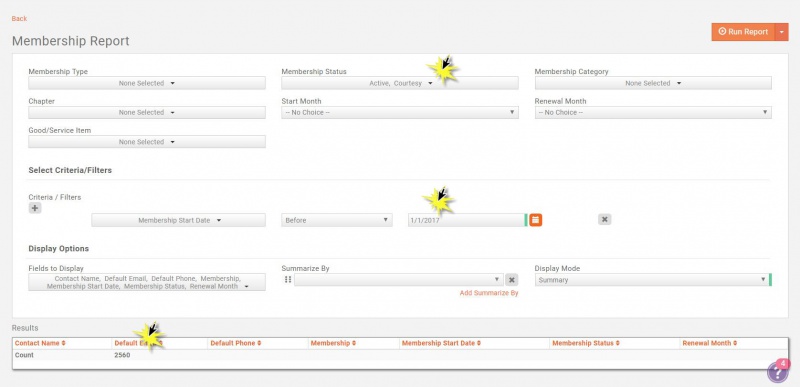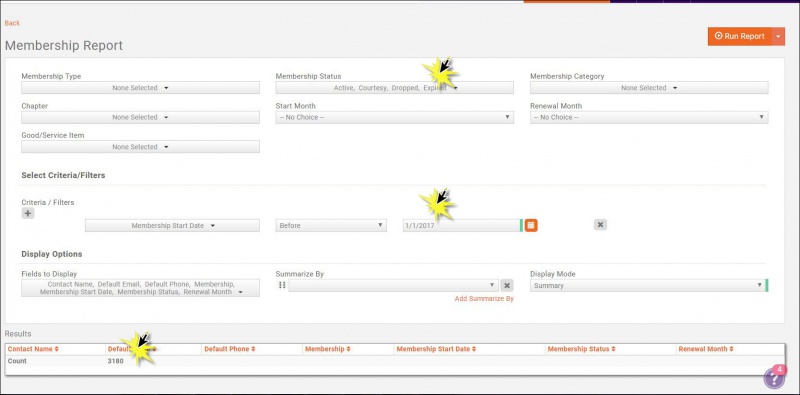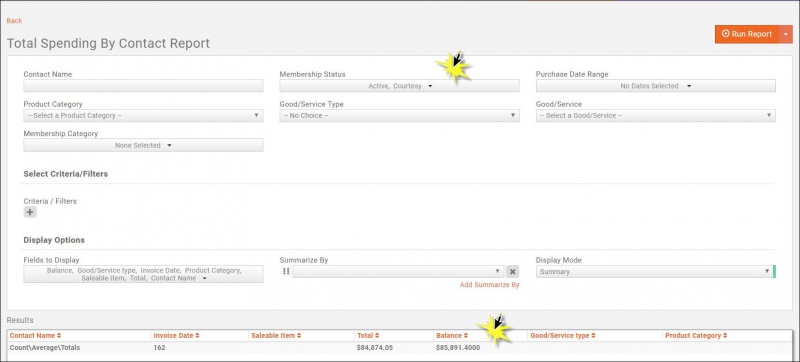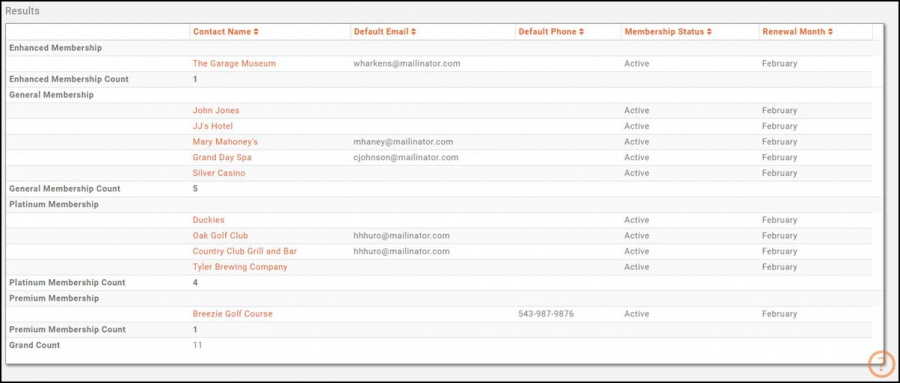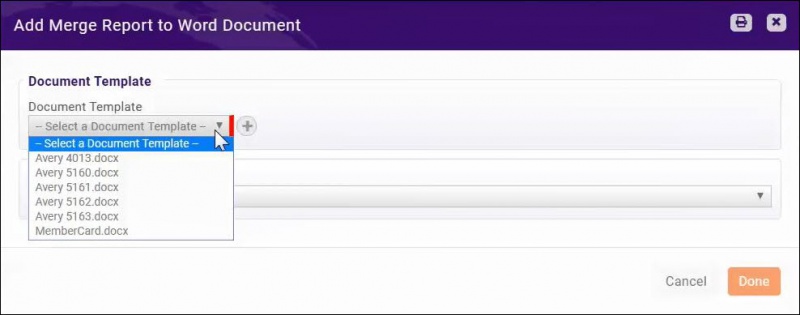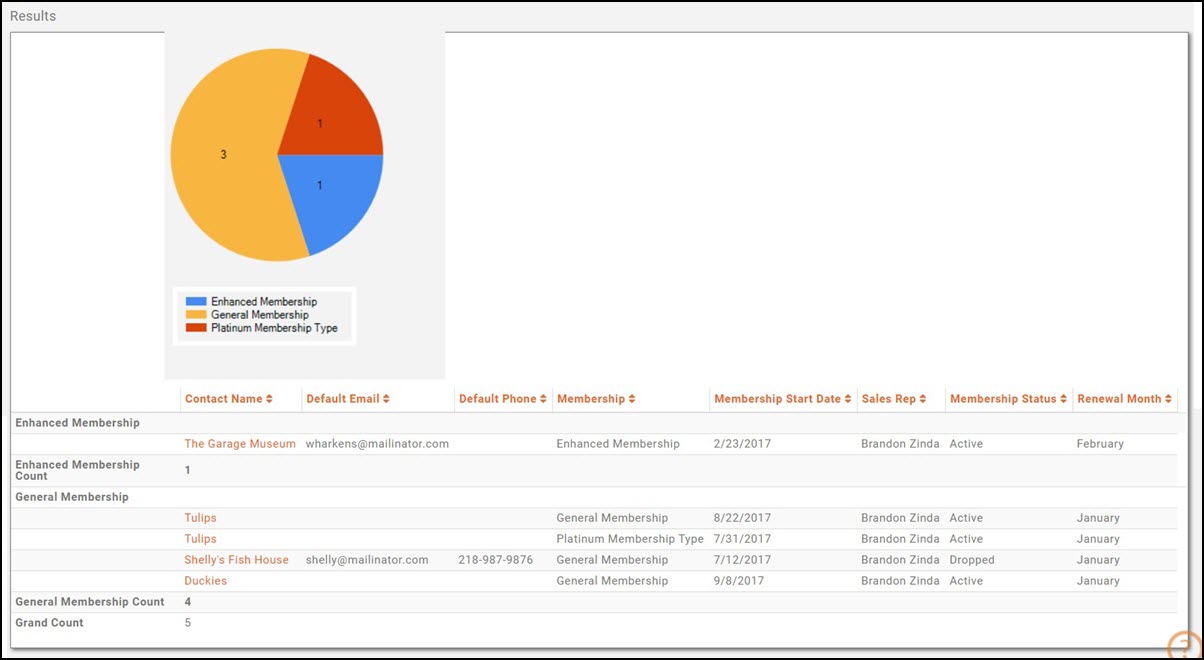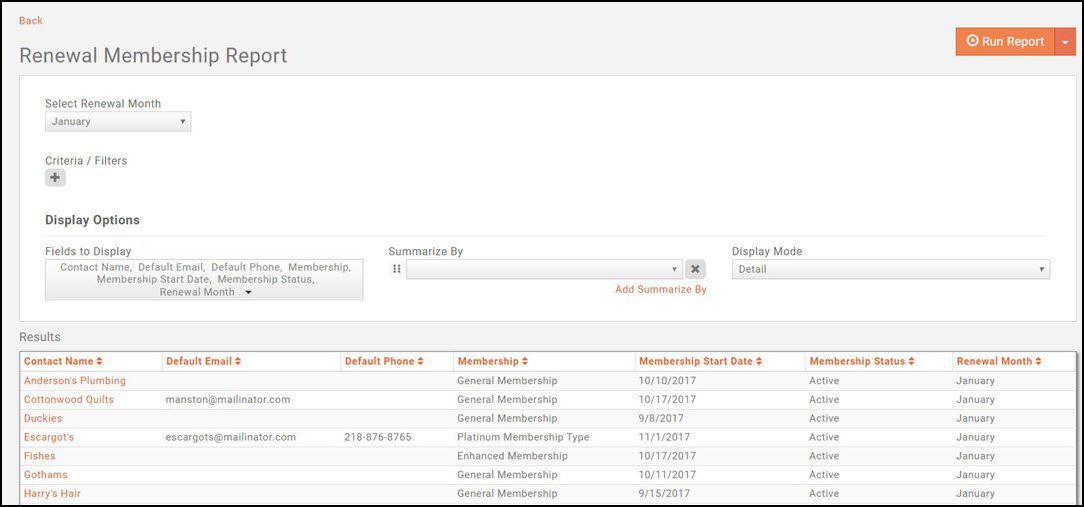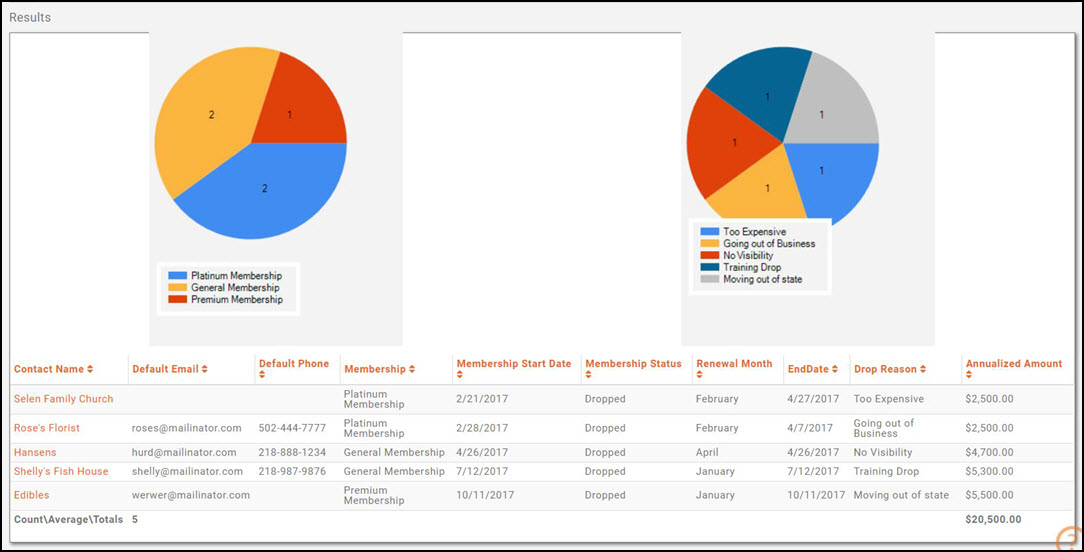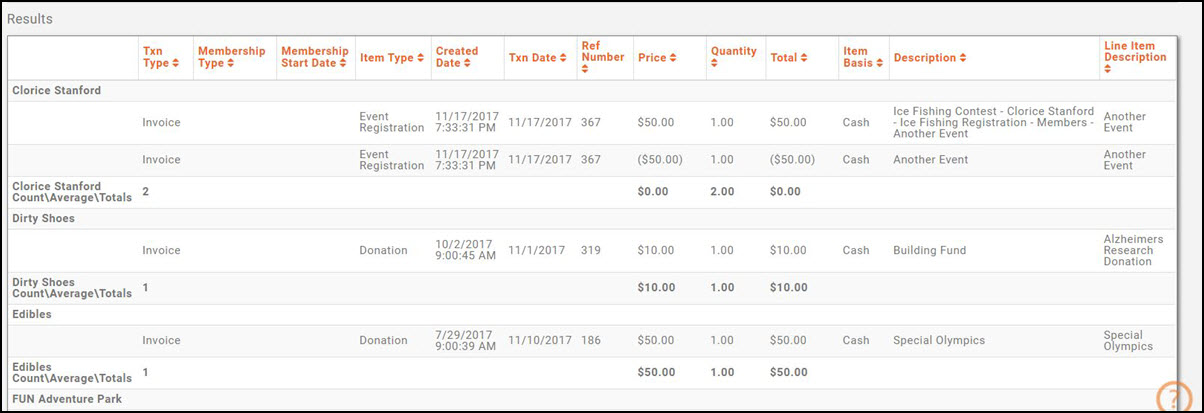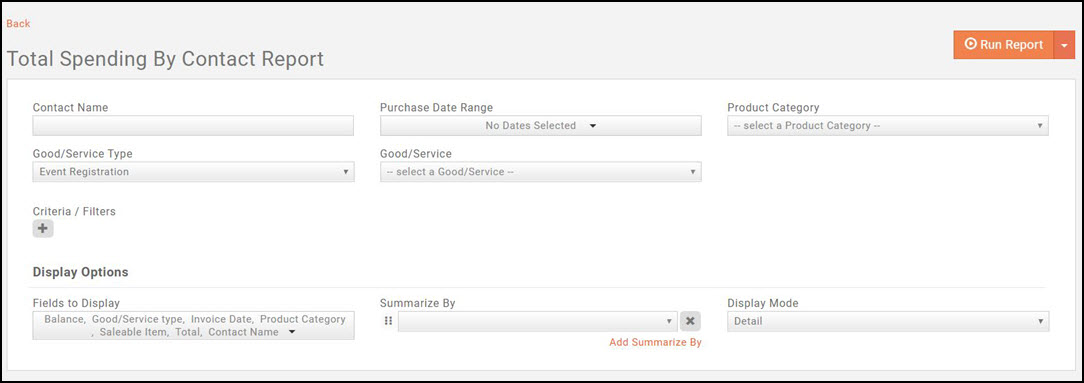Difference between revisions of "Membership Management"
| Line 129: | Line 129: | ||
Best Practice: When you first enable '''Automatically Expires''' on your membership types, you may find many scheduled to drop, that you do not wish to drop or that you do not wish to send the automated email to. Review this report prior to enabling the '''Auto Expire Memberships''' setting. | Best Practice: When you first enable '''Automatically Expires''' on your membership types, you may find many scheduled to drop, that you do not wish to drop or that you do not wish to send the automated email to. Review this report prior to enabling the '''Auto Expire Memberships''' setting. | ||
| + | |||
| + | #Select '''Reports''' in the left-hand navigation panel. | ||
| + | #Search for and select the '''Memberships That Will Be Auto-Dropped''' report. | ||
| + | #:[[File:Autodrop report criteria.jpg|800px|center]] | ||
| + | #Select the desired filtering criteria. | ||
| + | #Click '''Run Report'''. | ||
| + | [[File:Autodrop results.jpg|800px|center]] | ||
==='''<span style="color:#800080">Add Pricing to a Membership Type'''</span>=== | ==='''<span style="color:#800080">Add Pricing to a Membership Type'''</span>=== | ||
Revision as of 13:07, 16 July 2019
Contents
- 1 Membership Settings
- 2 Manage Account and Membership Number Assignment
- 3 Understanding Membership Types
- 3.1 View Membership Types
- 3.2 Add a New Membership Type
- 3.3 Membership Auto-drop (Coming Soon)
- 3.4 Add Pricing to a Membership Type
- 3.5 Setup Variable Dues Calculations
- 3.6 Setup Membership Type Directories & Categories
- 3.7 Setup Membership Type Levels
- 3.8 Setup Membership Application Form Fields/Questions
- 4 View/Create your Membership Application Form
- 5 Approving On-line Membership Applications
- 6 Configuring Membership Join/Drop Reasons
- 7 Add a Membership to a Contact
- 8 Manage Member Recurring Fee Schedule
- 9 Viewing/Updating Member Information
- 9.1 Viewing/Editing Membership Details
- 9.2 Update Contacts Related to a Membership
- 9.3 Manage Membership Change
- 9.4 Membership Reports
Membership Settings
Several global settings may be configured for overall membership management.
- Click Settings in the left-hand navigation panel.
- Click Membership Settings in the Services, Products and Commerce section.
- Configure the following:
- Membership Removal Does Not Remove Chapters Or Lists: This setting allows you to configure whether contacts are removed from chapters and lists when the membership is dropped. If this option is not selected, contacts are automatically removed when the member if dropped.
- Prorate Cutoff Day: This option allows you to configure the cutoff day for pro-rated membership dues. The default is 15. If a new membership is added prior to this cut-off, the full month's membership will be charged. If a new membership is added after this cut-off, the new member will not be charged for the month. See Understanding Pro-rating for further information.
- Click Save.
Manage Account and Membership Number Assignment
You system may be configured to automatically assign account and membership numbers to new contact.
- Click Setup in the left-hand navigation panel.
- Click Account and Membership Numbers in the Miscellaneous section.
- Configure the following as needed:
- Contact Account Numbers
- Automatically Assign Account Numbers To Individuals: Enable this option if you wish the system to automatically assign an account number to individual members.
- Automatically Assign Account Numbers To Organizations: Enable this option if you wish the system to automatically assign an account number to business members.
- Enforce Account Number Uniqueness: Enable this option to ensure that account numbers assigned are unique. If a number has been assigned to one account and a staff member later tries to edit another account and use that number, they will be alerted.
- Contact Assignment Trigger Type: Select at what point you wish the account number to be assigned. When created will assign an account number to all contacts in the database, regardless of status. When active will assign an account number when the membership status is active. When active and courtesy will assign an account number when a membership is activated or marked as courtesy.
- Next Account Number Assigned: This field will keep track of the account numbers to be assigned, and will default to 1. If you wish to start the sequence at a different value (for example: if you are new to the software, and currently have account numbers assigned to your members) enter the starting account number. All subsequent number assignments will key off that starting number and auto populate.
- Membership Numbers
- Automatically Assign Membership Numbers: Enable this option if you wish the system to automatically assign membership numbers to your members.
- Enforce Membership Number Uniqueness: Enable this option if you wish to ensure that membership numbers are unique. If a number has been assigned to one account and a staff member later tries to edit another account and use that number, they will be alerted.
- When to assign: Select at what point you wish the account number to be assigned. When created will assign an account number to all contacts in the database, regardless of status. When approved will assign an account number when the membership status is active.
- Next Membership Number Assigned: This field will keep track of the membership numbers to be assigned, and will default to 1. If you wish to start the sequence at a different value (for example: if you are new to the software, and currently have membership numbers assigned to your members) enter the starting membership number. All subsequent number assignments will key off that starting number and auto populate.
- Contact Account Numbers
- Click Save.
Understanding Membership Types
Membership Types allow you to define the membership packages and fee items you wish to provide to your members. These membership types my be included on your membership application form.
View Membership Types
- Click Membership in the Navigation panel.
- Click the Membership Types tab. A list of membership types currently setup in your system will be displayed.
| NOTE: The icons in the left hand column indicate:
|
Add a New Membership Type
- Click Membership in the Navigation panel.
- Click the Membership Types tab. A list of membership types currently setup in your system will be displayed.
- Click the Add button.
- On the Add Membership Type screen, configure the following:
- Name - Enter a name for the new membership type. This is the name that will appear on you member application, as well as within in the database where you may choose a membership type, filter by membership type, report on membership type, etc.
- Term/Length(Months) - Enter the duration of this membership, in months. The default is set to 12 months.
- Owned By - This setting allows you to set this membership type as either organization or individual level. If Business is selected, invoices will billed to the organization; if Individual is selected; invoices will be billed to the individual.
- Membership Category - Membership Categories provide a way to further filter and report on your membership types. Select a Membership Category from the drop-down list, or click the plus sign to add a new membership category.
- Is Active - enable this option to activate the Membership Type. Best practice, when no longer using a Membership Type, is to de-activate.
- Chapter Options: - If using the Chapters module, configure the following as necessary:
- Allow Multiple Chapter Selection - If you allow applicants to choose more than one chapter when filling out the Membership Application Form, enable this setting.
- Allow Single Chapter Selection - This option should only be selected if you allow for selection of only one chapter during the application process.
- (Optional) Calendar Year Renewal - These options allow you to manage when your renewals will occur and manage prorating your fees.
- Renewal Options:
- End Type: Select Manually Ended, if you wish to manually drop members. Select Automatically Expires if you wish to setup 'Auto-drop. If Automatically Expires is selected, enter the desired Grace Period. See Membership Auto-drop for further details.
- Renew Everyone In - This setting allows you to establish the renewal month to' be applied to all members.
- Prorate Partial Years - Selecting this check-box will automate the process of adjusting the membership fees, based on the month that the member joined. NOTE: When applicants are presented with the amount that they are paying on the membership application it will correctly represent the amount that they will pay now as the prorated amount (if applicable) and the amount they will be billed in the future.
- NOTE: Calendar Year Renewal with or without Prorate enabled is intended to work for memberships with a 12 month term and with standard frequency selections i.e. Monthly, Quarterly, Semi-Annual and Annual) (do not use with Once Per Term Frequency). Refer to Understanding Pro-rating for further details on setting up a pro-rated membership type.
- Description: Provide description of the membership type. This description may be displayed on your web-site. You may use the standard word processing icons (i.e. bolding, italicizing, etc.) to format the text. You may also add images and/or links to the description.
- Click Done.
Once you have created your membership types, you may wish to:
- Add Pricing to a Membership Type
- Add Directory/Categories to a Membership Type
- Add Membership Type Levels - COMING SOON!
- Setup Membership Application Form Fields/Questions
Membership Auto-drop (Coming Soon)
The GrowthZone Auto-drop functionality automates the process of dropping contacts, when they have not paid their membership dues, after a pre-determined number of days.
Steps for enabling auto-drop
- Set the desired Membership Types to Automatically Expires. You can update any of your existing Membership Types as needed. See Add a New Membership Type for instructions.
- (Optional) Set a Grace Period. The system will use the grace period days, to determine when the contact will be dropped. If no you do not allow a Grace Period, set this to zero.
- Review the Memberships Will Be Auto-Dropped Report. If you are just getting started with auto-drop, best practice is to review this report to ensure the accuracy of those memberships that the system is scheduled to automatically drop. See Memberships Will Be Auto-Dropped Report for further information.
- Enable Auto Expire Memberships under Setup > Membership Settings.
- Set Default Access Level for auto-drops. This setting allows you to configure the Info Hub access level of contacts associated to the dropped membership. This is configured under Setup > Membership Settings. NOTE: This access level only applies to those auto-dropped.
Auto Expire Memberships Process
The Auto Expire Memberships process runs nightly, to evaluate members that should be dropped. Memberships will be automatically dropped the day after, the latest of these dates:
- Membership Expiration Date
- Grace Expiration Date
- Invoice Due Date: If an unpaid membership invoice is associated to the membership, this date is used. NOTE: Only invoices generated by the automated setting Use Automated Billing, or manually generated from Upcoming Billing are reviewed for this date.
Once a members is auto-dropped, the Membership Has Expired email is automatically sent. See below.
Membership Has Expired Email Messaging
When a contact is auto-dropped, the automated email message Membership Has Expired will be sent. You can review and edit this email message as needed. See Configure Automated Messaging for further instructions.
| NOTE: This email is only sent to those that have been auto-dropped. If you do not wish an email to be sent to a member, manually drop from the member's general tab. |
Memberships Will Be Auto-Dropped Report
The Memberships Will Be Auto-Dropped Report will provide you with a list of all contacts that are scheduled to be dropped on a given day.
Best Practice: When you first enable Automatically Expires on your membership types, you may find many scheduled to drop, that you do not wish to drop or that you do not wish to send the automated email to. Review this report prior to enabling the Auto Expire Memberships setting.
- Select Reports in the left-hand navigation panel.
- Search for and select the Memberships That Will Be Auto-Dropped report.
- Select the desired filtering criteria.
- Click Run Report.
Add Pricing to a Membership Type
- Click Membership in the Navigation panel.
- Click the Membership Types tab. A list of membership types currently setup in your system will be displayed.
- Click the value located in the Pricing column, or if no pricing has been entered yet click the <No Pricing> link.
- Configure the following as desired:
- Payment Gateway: You may select the payment gateway you wish to use for this membership type. If no gateway is selected, the default gateway for your organization will be used.
- Invoice Template: You may select an invoice template. If no invoice template is selected, the invoice template associated to the fee items will be used.
- Payment Terms - The default payment terms are selected, and you may select alternate payment terms. You can add new payment terms by clicking the + icon.
- Terms/Conditions - The default payment terms are selected, and you may select alternate payment terms. You can add new terms and conditions by clicking the + icon.
- Formula Based Pricing: Click the check-box, if you are setting up a membership type that will use variable dues.
- Recurring Fees: Recurring fees would include, for example, the annual membership fee. This is considered the base pricing for the membership. Click the + button to add a recurring fee to this membership type. You may add as many recurring fees as needed.
- Select a good/service from the Item drop-down list.
- Enter a Description of the item.
- Enter the Price: This is the base price fee for this membership type, and reflects the term defined when you created the membership type.
- Billing Options: Click the Billing Options link to set specific options for this fee.
-
- Hide On Invoice/roll up price into the highest priced, unhidden item (typical for bundling): If you do not wish to display this item on an invoice, enable this option.
- Collect this fee upfront with first payment / it can't be spread: If this fee item should be collected, with the first payment, regardless of payment options you define, enable this options. For example: The fee item might be a recurring contribution to a fund, and should always be paid up front when a member first joins, and each renewal afterwards. See Configure Payment Options for Membership Types for further information on special payment options.
- Exclude from Price Change %: If you do not wish to include this fee in the Price Change % increase or decrease, enable this option. See Configure Payment Options for Membership Types for further information on special payment options.
- Click Done.
- Setup/One Time Fees - If there are one time fees, such as a setup fee, associated with this membership, you may add them by clicking the + button.
- Select a good/service from the Item drop-down list.
- Enter a Description of the item.
- Enter the Default Price.
- Select the Hide on Invoice check-box if you do not wish to display this item on the invoice. If this option is selected, the amount of the item will be added to the first visible line item on the invoice. NOTE: If viewing the invoice in the back office, staff will see all line items regardless of whether the "Hide on Invoice" was selected on the Membership.
- Payment Options: Payment options provide flexibility in pricing, frequency, and payment options for this membership type. For example: If you wish to offer a monthly frequency, but will charge more for this option, you will configure this within the Payment Options. See Configure Payment Options for further details.
- Click Done.
Configure Payment Options for Membership Types
Payment Options allow you to offer different options for the frequency at which your members wish to be billed. Within the payment options, you will be able to configure which billing frequency options you wish to offer, whether invoicing and/or credit cards payment is an option for a selected frequency, and set a percentage increase or decrease for the selected frequency.
For example: If you wish to offer a monthly frequency, but only if paid by credit card, you will set this up under the Payment Options.
Features:
- When new members are brought on through the membership application or from the back office, you have the ability to offer monthly, quarterly, semi-annually or annual payment options.
- For Example: you could charge a bit extra if a member chooses monthly or charge a bit less if they pay annually or if the member selects monthly payments, you may not want to allow them to be invoiced but if annual, an invoice might be fine.
- While allowing these flexible options, the association may also have guidelines to follow where:
- A certain fee among all the membership fees may not be collected monthly, although the rest can be.
- A certain fee cannot be adjusted according to monthly or annual selections.
To setup up your Payment Options setup your membership pricing, as described in Add Pricing to a Membership Type. Then, for each frequency option you wish to offer:
- Allow: Select the payment options you wish to offer on your membership application. Staff will have all frequencies available from the back office. NOTE: Frequency options available will be determined by the term of them membership type. For example: If the term of the membership type is 12 months, the system will automatically provide options for Annually, Semi-annually, Quarterly and Monthly. If the term of the membership is 7 months, the system would allow for a monthly option and a once per term option.
- Allow Invoicing: This setting allows you to configure, per frequency, whether you will let the applicant select an invoice me option.
- Allow Credit Cards: This setting allows you to configure, per frequency, whether you will accept credit card or ACH payments.
- Price Change %: This setting allows you to increase or decrease the base price, per frequency. To increase the base price enter a positive number and to decrease the price enter a negative number. For Example: If you offer a monthly frequency option but wish to increase the base price for this option by five percent, enter 5. Conversely, if you would like to provide an incentive to pay annually, by decreasing the base price by five percent, enter, -5. NOTE: Price Change is optional. If you simply wish to setup the invoicing and credit card options for each frequency, you can leave these fields blank, and the system will simply calculate the frequencies based on the term you have configured.
The Per Bill Amt column will be updated immediately to display the amount that will be billed, based on the frequency & percent change you have entered.
Payment Options - Special Use Cases
Collect a fee with first payment
You can choose to include a recurring fee item, that must be paid in full "up-front". In this case, the Per Bill Amt will take this into consideration when calculating. As shown below, a fee of $120.00, has been added to the recurring fees schedule, and set to Collect this fee upfront with first payment / it can't be spread under the billing options. This is reflected, in the Per Bill Amt as shown below.
Exclude a fee from discounts/adjustments
You may choose to exclude certain fee items from Price % adjustments. For example if you have a State or National Fee in your base price that is non-negotiable, you may not wish to adjust this fee item. By selecting Exclude from Price Change % for a fee item, in the Billing Options described above, the Price Change % will NOT be applied to that fee item.
Understanding Pro-rating
When setting up your Membership Types, an option is available to set a specific renewal month and to enable pro-rating. The scenarios below explain specific use cases for your pro-rating setup. NOTE: Calendar Year Renewal with or without Prorate enabled is intended to work for memberships with a 12 month term and with standard frequency selections i.e. Monthly, Quarterly, Semi-Annual and Annual. Do NOT use with a Once Per Term Frequency.
| NOTE: By default, Memberships that have Prorate Partial Years enabled will charge applicants that join on the 1st - 15th of the month for the full month. Applicants joining after the 15th will receive the current month for free but will be charged for the next term.
You can change the cutoff day of the month by selecting the Prorate Cutoff Day under Setup > Membership Settings. The default Prorate Cutoff Days is 15. This value is used to determine whether the membership should bill for that month. For Example: Prorate Cutoff Day = 15, a new member signs up on the 3rd, the new member WILL be charged for that month. A new member signs up on the 15th, the new member WILL be charged. A new member signs up on the 20th, the new member WILL NOT be charged for that month. |
- Calendar Year Renewal Month specified, Prorate on, Monthly Frequency: When Renewal Month is specified on your membership type and Prorate is On with Monthly frequency specified, the upfront, initial charge/invoice includes the next month’s amount, so the applicant is always charged for something when they sign on.
- For Example: Renewal Month = January, Monthly Frequency, Prorate=On, $100/month
- A new member signs up in February. The new member will be invoiced $100 immediately (for March). The Next Scheduled Billing date will be in April for $100/monthly.
- Calendar Year Renewal Month specified, Prorate Off, Frequency=Monthly, Quarterly or Semi-Annual: If you have the optional Renewal Month specified for a membership type with Prorate Off and frequency set to Monthly, Quarterly, or Semi-Annual all the previous months' charges will be included in the upfront, initial invoice/charge bill so the applicant is always up to date on the previous months when they sign on as these memberships are NOT being prorated.
- For Example: Renewal Month = January, Monthly frequency, Prorate=Off, $100/month
- New member signs up in April. The new member will be invoiced $400 (Jan – April). Next Scheduled Billing will be in May for $100/monthly
- Calendar Year Renewal specified, Prorate=On, Custom Frequency: The new member will be charged for the amount that is appropriate for the frequency selected, i.e. Monthly would be a monthly amount, quarterly a partial quarterly amount, Semi-annual = a partial semi-annual amount.
Setup Variable Dues Calculations
Variable Dues calculations allow you to structure dues that vary for each member dependent on a factor of their business. Examples of such factors are number of employees, annual revenue, production volume, etc. , Use Variable Dues calculations when your memberships have these characteristics:
- The pricing varies dependent on one or more factors (numeric inputs). For example, a factor could be the number of employees, number of beds in a hospital, or rooms in a hotel. Multiple variables may be used.
- The factor is based on information that the member knows (For example: # of employees, # of cattle, # of buildings managed, # of beds, annual revenue).
- When the membership is a combination of levels and variable pricing.
Example scenarios handled by variable pricing
- If pricing needs to be determined by calculating by a specific rate. For Example: Revenue = Annual revenue x .005
- If pricing for each level varies based on one variable input by the customer. For Example: Hotels = Base price of $435 + $7/additional sleeping rooms above 55.
- If pricing for each level varies based on multiple variable input by the customer. For Example: Employees = ($10 per full-time employee) + ($5 per part-time employee) with a max price of $1,000.
Steps to Setup Variable Dues Calculations
- Determine which fields are needed for your formula (i.e. full-time employees, part time employees, number of beds, number of cattle, etc.). Create the custom fields needed to calculate your variable dues. For example, if your variable dues are based on a number of employees, you will need to create this as a custom fields. See Setup Membership Application Form Fields/Questions for instructions. Custom fields created as decimal or integer type will be available when setting up your calculations.
- Create your membership type(s). See Add a New Membership Type for instructions.
- For the desired membership type, click the <No Pricing> link, in the Pricing Column.
- Click the Formula Based Pricing check-box. See Add Pricing to a Membership for information on additional fields.
- In the Recurring Fees section, click the
 to add the fee item(s) for the membership type:
to add the fee item(s) for the membership type:
- Select the fee item from the Item list. The Description, Price, and Frequency fields will be populated based on the defaults configured when the fee item was set up. The price you select would be the base price for the membership. NOTE: A base price is NOT required and pricing could simply be based on your formula calculations.
- Click the
 next to the Price text box to add the variables required by your formula. For example this would be where you would choose full time employees as the variables needed in your calculation, as well as enter the amount to be charged for those employees.
next to the Price text box to add the variables required by your formula. For example this would be where you would choose full time employees as the variables needed in your calculation, as well as enter the amount to be charged for those employees.
- If you would like to set a maximum price for this membership, enter it in the Maximum Price (optional) field. This will set a "cap" on the total fees that a member will incur.
- Click the
 to add your variables (custom fields) and setup the formula calculations.
to add your variables (custom fields) and setup the formula calculations. - Select the field to be used in your calculation from the Unit Field list. Custom fields that are integers or decimal will be listed.
- Enter a Unit Price. This is the dollar value that will be used to calculate the dues. For example, if you will charge one dollar for each full-time employee, enter 1.
- Enter the Base Units Included in Price. Entering a “base unit included in price” will subtract this number from the amount entered in the field and the calculation will occur on a value greater than 1. For example, if there are 100 full time employees and 55 are included in the base, the calculation will occur on the remaining 45.
- Repeat steps 7 - 10 above to add additional calculations. In the example shown below, for each full-time employee over 50, the system will multiply by $1.00 and add the result to the base price (if applicable). For each part-time employee over 25, the system will multiply by $.50 and add the result to the base price (if applicable).
- Click Done.
| NOTE: Custom Calculations: If a calculation is more complex that what is allow here, GrowthZone can write a custom calculation script for it. These calculations must be reviewed in advance by our product/development team before any commitment that it can be scripted. GrowthZone may assess fees for custom calculations. |
Variable Dues - Auto-assign Levels
With your variable dues, you have the ability to "auto-assign" levels to your members. Assignment is based on one of the factors included in your formula. For example, include full-time employees in your formula, then create levels (such as 1 - 50 employees, 51 - 100 employees, etc.). When the number of full-time employees is enter by the applicant on your application form, or by your staff through the back-office enter, the system will automatically assign the member to the correct level.
- On the Membership Type tab, click the <No Levels> link in the Levels column, for the membership to which you wish to add levels. NOTE: If you have already added levels, click the numbered link.
- Select the field to be used for assigning levels from the Field Used to Determine Level (Min and Max are set with with each level) list. Fields displayed are those you have selected for your variable dues formula.
- In the Levels section, click the
 icon, to add levels.
icon, to add levels.
- Enter a Name for the level.
- Enter the Minimum Units (>=) and Maximum Units (<=) values to be used in determining if the member should be assigned to this level. For example, if you have a level for 1 - 50 employees, enter a Minimum of 1 and a Maximum of 50. A member who enters 1 to 50 full-time employees (inclusive) would be assigned to this level
- Add Fees if applicable, however, with variable dues, fees are configured under the Pricing functions. If fees are added, these fees would be in addition to the fees assigned under pricing.
- Click Done.
- Repeat steps 4 - 7 above to add additional levels.
- Click Done.
Gather Variable Dues Information on the Membership Application Form
When an applicant selects a membership type that includes variable dues, on the second page of the Membership Application for, a section called Information for Dues Calculations will be displayed. These are the custom fields you created as numeric input to the dues formula. Based on the input into these fields, the system will calculate the appropriate dues.
Add a Variable Dues Membership Type to a Contact from the Back Office
When adding a membership for which pricing is setup on a formula, an Information for Dues Calculation section will be displayed on the Add a Membership screen. Your staff will enter the appropriate values, and the system will calculate the additional fees based on the formula setup for the membership type.
See Add a Membership to a Contact for further information on adding memberships. Changes to the variables may be made when upgrading and downgrading the membership.
Setup Membership Type Directories & Categories
Membership Types may associate to a particular Directory, and to a set of Directory Display Settings. Directory Display Settings control what information about a business or individual is displayed if you choose to publish a directory of members to your website. You may, perhaps, have different levels of listings based on membership type. A basic level might include just a business name and a logo, where as an enhanced listing may include photo galleries, videos, maps, etc.
To add a directory and directory display settings to a membership type:
- Click Membership in the Navigation panel.
- Click the Membership Types tab. A list of membership types currently setup in your system will be displayed.
- Click the numbered link or the <No Directories/Categories> link in the Directories/Categories column for the Membership Type to which you wish to associate directories/categories.
- Configure the following:
- Directory Listing: Click the
 to add a directory, and directory display settings to this Membership Type.
to add a directory, and directory display settings to this Membership Type.
- Select the Directory you want the members of this membership type to be included on.
- Select the Directory Display that is automatically assigned to the member with this membership type. If needed, click the
 to add a new directory display. Click Here for further information on Directory Display Settings.
to add a new directory display. Click Here for further information on Directory Display Settings.
- Directory Categories
- Display Directory Categories: Check the box to display directory categories to your members on the membership application and the Info Hub. Click the icon to configure the directory categories for this membership type. Choose the Category List you want your members to choose from. If needed, you are also able to select a minimum and maximum number of categories that each member is able to select.
- Directory Listing: Click the
- Click Done.
Understanding Directories
You system will contain a default directory, Active Member Directory. This directory is tied to your Business Category and may contain all of your valued members. It also is configured with the Standard Listing directory listing type. Advanced options, including searching by custom field may be configured for the default. If needed, you may create additional directories. Click Here for information on creating a new directory
Understanding Directory Display Settings
Directory Display Settings control what information about a business or individual is displayed if you choose to publish a directory of members to your website. You may, perhaps, have different levels of listings based on membership type. A basic level might include just a business name and a logo, where as an enhanced listing may include photo galleries, videos, maps, etc.
To Add a new Directory Display Settings:
- Click Setup in the left-hand navigation panel.
- Click Directory Display Settings in the Website section.
- You system will be populated with the Standard Listing and the Deluxe Listing listing types. You may use these as designed or click the hyper-linked name of a listing to edit.
- Click the Add button.
- Configure the following:
- Name - Provide a name for the Directory Display Settings.
- Description - Provide a description of the Directory Display Settings.
- Show Individual Details - Select which details for your individuals will be displayed when this directory display setting is used.
- NOTE: When address, email and phone are selected, you can then choose which address type (i.e. mailing, physical, etc.), which email type (work, personal, etc.) and which phone type (main, toll, etc.) you will display with this listing type.
- Show Custom Fields - Select the custom fields you want to display in the directory.
- Options - select the additional options to display in the directory:
- Show Membership Type - If selected the member's membership type will be displayed in the directory.
- Show Search Logo - If selected the member's primary image will be displayed when the directory is searched.
- Show Highlights If selected, a highlights section will be displayed on the web-page.
- Show Related Contacts - If selected, all of the individual associated to the member will be displayed on in the directory. NOTE: If an individual does not wish to be displayed in the directory, you may disable the Show as Related or Primary Contact in directory (if applicable) setting for that contact.
- Show Search Description - If selected, you will be able to add a short description to be displayed on the directory search page.
- Show Gallery - If selected, the member may display a gallery of photos on the web-page.
- Show Video - if selected, the member may display a video on the web-page.
- Show Map - if selected, the location of the organization will be displayed on map on the web-page.
- Show Primary Contact - if selected, the name of the primary contact will be displayed on the web-page.
- Use Contacts Website for Listing page - If selected, clicking on the member on your public web-page will lead to the contacts website, instead of your page. Applicable only when assigned to a public directory (not available in the Hub).
- Retargeting
- Google Tag Manager Container ID - Enter the Container Id you were provided on installation of Google Tag Manager. Google Tag Manager is a free tool that makes it easy for marketers to add and update website tags -- including conversion tracking, site analytics, re-marketing, and more—with just a few clicks, and without needing to edit your website code.
- Click Done.
Setup Membership Type Levels
Membership Levels allow you the flexibility to offer the same membership, but offer different prices. For example, you may offer a Small Business Membership, where pricing is based on the number of employees:
- Small Business Membership – 1 – 5 employees
- Small Business Membership – 6 – 15 employees
- Small Business Membership – 16 – 25 employees
This would be one membership type (Small Business Membership) with 3 levels.
Membership levels should be used when your Membership Types have these characteristics:
- Membership Name is the same except for level assignments
- The applicant can self-select which level is appropriate
- Information is not needed from the association to determine the level
- The selection is based on information that the member knows (Seats in the restaurant, # of Employees, etc.) or based purely on the desires of the member (Gold, Silver, etc.).
- The pricing is fixed for each level
- This is NOT variable pricing but fixed, pre-determined pricing based on the selected level
- Each level uses the same Directory assignments and number of Categories
Add Levels to a Membership Type
| NOTE: You may add up to 50 levels to a Membership Type. |
- In the Membership module, click the Membership Types tab.
- In the Levels column, click the <No Levels> link in the row for the membership you wish to add levels to. NOTE: if levels have already been added to a membership type, click the numbered link in the Levels column.
- Click the
 to add a level.
to add a level.
- Enter a Name for the level. This name will be displayed for selection on your membership application form. Do not repeat the Membership Type Name as the Level Name NOTE: Names may be unique but are not required to be unique per Membership Type.
- Click the
 icon to add Recurring Fees to this membership level. NOTE: If you have set pricing for the membership type, the recurring fees set for the level are in addition to the base fees. It is not necessary to create a base fee. See Add Pricing to a Membership Type for further information. When invoicing, two line items would be displayed: one for the base fee, and one for the level fee.
icon to add Recurring Fees to this membership level. NOTE: If you have set pricing for the membership type, the recurring fees set for the level are in addition to the base fees. It is not necessary to create a base fee. See Add Pricing to a Membership Type for further information. When invoicing, two line items would be displayed: one for the base fee, and one for the level fee.
- Select the desired fee item from the drop-down list. If needed, click the
 icon to add a new fee item. Each level may re-use the same Goods/Service Item if desired but do not have to. Best practice: Select Goods/Service based on how your account wishes to track income. If income is to be tracked for each individual level, select different Goods/Services. If no breakout is needed, you can use the same Goods/Service.
icon to add a new fee item. Each level may re-use the same Goods/Service Item if desired but do not have to. Best practice: Select Goods/Service based on how your account wishes to track income. If income is to be tracked for each individual level, select different Goods/Services. If no breakout is needed, you can use the same Goods/Service. - The Description of the fee item will be populated with the description provided when the fee item was configured. The Description is what is displayed on the invoice.NOTE: The Membership name would include Type+Level+Chapter where applicable.
- The Price will be populated with the price set when the fee items was configured. You may change this if you wish.
- The Default Billing Frequency will be populated with the frequency configured when the fee item was setup. You may change this if you wish. NOTE: If you have setup base pricing for this membership type, the frequency defined at the base level will be displayed. If you change the frequency for a level, it will also change the frequency of the base pricing, as well as the frequency for any previously created levels.
- Repeat Step 5 above to add additional recurring fees.
- If you wish to add Setup/One-Time Fees click the
 icon. NOTE: If you have set one time fees for the membership type, the one time fees set for the level are in addition to the one time base fees. See Add Pricing to a Membership Type for further information.
icon. NOTE: If you have set one time fees for the membership type, the one time fees set for the level are in addition to the one time base fees. See Add Pricing to a Membership Type for further information.
- Select the desired fee item from the drop-down list. If needed, click the
 icon to add a new fee item.
icon to add a new fee item. - The Description of the fee item will be populated with the description provided when the fee item was configured. You may change this if you wish.
- The Price will be populated with the price set when the fee items was configured. You may change this if you wish.
- Repeat step 7 above if you wish to add additional one time fees.
- Click Done.
Repeat steps 2 - 8 above to add additional levels to your membership type. You may add up to 50 levels.
If you choose to include this membership type on your Membership Application form, applicants will be able to select the desired level from a drop-down list. The levels, their name and pricing will be displayed. NOTE: If you have enabled the Hide Pricing on Membership Selection option for your Membership Application form, pricing will not be displayed on the first page of the application. If enabled, pricing will only be displayed once a member reaches the payment page. See View/Create your Membership Application Form for further information.
Additionally, when adding a membership from the back-office, you will have the ability to assign the level. See Add A Membership to a Contact for details.
The membership level will display on the contact's Profile tab in the Memberships section. The Membership name will reflect Type+Level+Chapter if applicable.
Adjust Membership Type Levels
Membership Type levels may be adjusted when you upgrade, downgrade or re-activate a Membership. See Managing Membership Change for instructions.
Adjust Membership Type Level Pricing
When it is necessary to increase the pricing of your levels, you will update the pricing from the Membership module.
| NOTE: Price changes will only take effect on a go forward basis. Memberships that have already been assigned, and for which a recurring fees schedule has already been created will NOT be updated. These price changes will need to be done on a case by case basis. See Adjust a Contact's Membership Pricing for instructions. |
- Click Memberships in the left-hand navigation panel.
- Click the Membership Types tab.
- Click the numbered link, in the Levels column for the desired membership type.
- Click the link(s) for the level(s) that you wish to update.
- Adjust pricing as needed.
- Click Done.
Membership Level Reporting
Membership reports include:
- The Membership Type Name and Membership Level (and Chapter selection if applicable) in the output in the Membership column.
- An additional field called Levels that can be added to any membership report so you can sort by Levels.
See Membership Reports.
The Contact Report includes the Membership Name (Type+Level+Chapter) as the default when viewing the Membership Type results. See Contacts Report.
Membership Level Conversion Tool
The Membership Level Conversion Tool will be available in the software as early as March 19, 2019.
The Membership Level Conversion Tool can be used to convert existing Membership Types (those types created prior to the introduction of levels) to levels. For Example: If you have created distinct membership types for General Membership Type 1-5 Employees, General Membership Type 6 - 20 Employees, etc., these distinct membership types can be converted to a single membership type with multiple levels.
| NOTE: The Membership Level Conversion Tool is to be used by those organizations who created membership types suitable for levels, prior to the introduction of Membership Levels. If you have not previously created membership types, and wish to create membership types with levels, see Add a New Membership Types for instructions. |
Best Practices/Initial Prep for Conversion
- Create brand-new membership type(s) first. See Add a New Membership Types for instructions.
- Once your new Membership Type(s) is created, add the desired levels and pricing. See Setup Membership Type Levels setup for details.
- Convert your current membership types to levels living underneath that new membership type, as described below.
Using the Membership Type Converter Tool
- Click Setup in the left-hand navigation panel.
- Click Convert Types to Levels in the Miscellaneous section.
- Select the Current Membership Type that you wish to convert.
- Select the New Membership Type to which you wish to associate the current membership type.
- Select the Existing Level to which your current membership type should be converted. In the image shown below, the Bronze Membership type, will be converted to the Bronze Level underneath the Small Business Membership type.
- To add additional membership types to the conversion, click the
 icon, and repeat steps 3 - 5 above.
icon, and repeat steps 3 - 5 above. - Click Convert.
Post Conversion Check-list:
- Membership Application: Update your Membership Application to display the correct membership types. See View/Create Your Membership Application Form for further information.
- Membership Types Event Discounts: If you are using Membership Type discounts, you may need to adjust the specified membership types to allow your members to access those benefits. NOTE: Event Discounts cannot be assigned to a specific level, only the Membership Type. See Setup Discounts for Your Events for further information.
- Membership Type Descriptions: Once converted to a level, your previous descriptions will no longer be displayed on your membership application. You may need to evaluate your new membership type description to ensure it accurately describes your levels.
- Invoice Line Item Description: The description shown on your members’ invoices will come from the Description on each Membership Level line Item. Evaluate if your invoice descriptions need updating.
Setup Membership Application Form Fields/Questions
For each Membership Type, you can add/edit the fields you wish to include on your application form:
- Click Membership in the Navigation panel.
- Click the Membership Types tab. A list of membership types currently setup in your system will be displayed.
- Click the
 icon in the Fields column.
icon in the Fields column.
- For each of the fields in the standard list, you can configure whether these are displayed on the application for, as well as whether they are required.
- Membership Application Custom Fields: You may add additional fields to your application by clicking the
 icon. Click Here for further information on configuring custom fields. NOTE: Custom Fields will be displayed on the Membership Details screen, accessible from the Membership section on a contact's Profile tab, as well as on the contacts More Info tab.
icon. Click Here for further information on configuring custom fields. NOTE: Custom Fields will be displayed on the Membership Details screen, accessible from the Membership section on a contact's Profile tab, as well as on the contacts More Info tab.
- Repeat Step 5 above to add additional custom fields.
- (Optional) Click the Advanced Options check-box to add custom fields that are an attribute of the Memberhhip Type itself. These fields are not included on the application form, but may be for internal use. For Example: You may include a yes/no checkbox custom field that indicates if it should or should not sync with an API.
- Click Done to save.
Remove Custom Fields from Your Application
If you no longer wish to display a custom field on your application form, you can archive the field. By archiving you will maintain all of the historical information previously submitted for the form.
- For the desired membership type, click the
 icon in the Fields column.
icon in the Fields column.
- Select the pencil icon for the custom field you wish to archive.
- Tick the Archived check-box.
- Click Done.
Re-arrange the order of Custom Fields
- For the desired membership type, click the
 icon in the Fields column.
icon in the Fields column.
- In the Membership Application Custom Fields section, the first column of your custom fields, you will find the drag to reorder icon.
- Drag the custom fields in the order you wish.
- Click Done.
View/Create your Membership Application Form
A default application form is setup in your system. You may use it as it is configured, or you may customize to better meet your needs.
| NOTE: The questions included on your membership application form are driven by the field that you have have associated to your membership types. See Setup Membership Application Form Fields/Questions for further information. |
- Click Membership in the Navigation panel.
- Click the Membership Application Forms tab. A list of Membership Application Forms currently setup in your system will be displayed.
- Click the link for the default application form
- On the Add/Edit Membership Application Form screen, you may choose to customize the following:
- Name - Provide a name for the application form. This name is used internally.
- Description - Provide a description of the application form. This description is used internally.
- Options - Select the desired options for this application form:
- Collect Donations - Select this check-box if you would like to collect donations to your fundraisers from the individuals completing the application form. If selected, you will have the option to select the campaigns you wish to display on your application from the Display Only These Campaigns drop-down list.
-
- Display Membership Type Description - Select this check-box if you would like the membership type description to be displayed on the application form.
- Allow Single Chapter Selection - If you are using Chapters, select this check-box to allow applicants to select their chapter when filling in the application form. This option should only be selected if you allow for selection of only one chapter during the application process.
- NOTE: Selecting this option allows for ONE chapter selection only. If multiple chapter selection is needed, you must enable Allow Multiple Chapter Selections within the Membership Type.
- Display Membership Benefit Description - Select this check-box is you would like to display benefit package information on the application.
- Automatically Approve Applications - Select this check-box if you want to automatically approve on-line applications. If this is not selected, the new applicant will be available in your database, but their membership status will be listed as Pending Approval until a staff member has approved.
- Order Memberships Lowest Price First (if not selected, the order will be highest price to lowest) - Select this option if you wish to order your memberships from lowest price to highest price when displayed on your web-site. If not selected, the order will be highest to lowest.
- Hide Pricing on Membership Selection: Enable this option if you do not wish to show membership prices on the first page of your application form. If enabled, pricing will only be displayed once a member reaches the payment page.
- Collect Lists/Committees Subscriptions: If selected, the lists/committees that you have configured as Public Can Join will be displayed on the application form. Applicants would then be able to select the groups they wish to join.
- Display Only These Memberships - This option allows you to select which memberships to display on-line. By default, all memberships will be displayed, but you may change this if you wish to not display only certain memberships on your application form.
- Email To Send On Completion - An email will be automatically sent to the applicant when the complete the application. Select the email you wish to send from the drop-down list. A default Membership Application Confirmation Email template is selected, however, you may select a different template. Click here Communications Basics - Create and Manage Email Templates for further details on working with email templates.
-
- Instructions - Enter the instructions that you would like to display on the application form. You may use the standard word processing icons (i.e. bolding, italicizing, etc.) to format the text. You may also add images and/or links to the instructions.
- Completion Message - Enter the message you would like to appear when the applicant completes the application. You may use the standard word processing icons (i.e. bolding, italicizing, etc.) to format the text. You may also add images and/or links to the message.
- Additional settings for the Member Application Form may be displayed by clicking the Advanced Options check-box.
- Completion Page Url (Ex: http://www.msn.com) - Enter the URL of the page you would like the applicant to be sent to after completing the application.
- OR
- After Completion, Create a new Hub account - Select this checkbox if you would like the applicant to create their log-in to the Info Hub after submitting the application. A Create an Account in the Hub button will be included on the application submitted confirmation page.
- Destination Url within Hub (empty if Home) - You may enter a page specific URL for the Info Hub. For example, if you would like them to land on the account tab. If this is left blank, the page will open on the home page.
- URL - The URL for the membership application form is displayed. You make click on it to preview our application form.
- Click Done to save the application form.
| NOTE: In addition to the fields you have selected to display on your application form, lists/committees for which you have enabled Users Can Join and/or Public Can Join will be included on your application form. Click Here for information on creating/configuring your groups. |
On-line Membership Application Process Flow
When an applicant submits an on-line application the following will occur:
- The applicant will receive an email confirmation. The email sent will either be the email you have selected in the advanced options of your membership application form, or the default you set in Automated Messaging. Email is sent to address associated with the person who submitted the application.
- Those staff members who have subscribed to Membership Application Submitted notification will receive an email.
Approving On-line Membership Applications
Once a membership application form is submitted on-line, an automated email will be sent to those who have subscribed to the Membership Application Submitted notification. The default email notification is shown below.
Click Here to learn how to setup your Membership Applications for automated approval.
If you have chosen to not automatically approve on-line membership applications, you will need to approve the applications when they are submitted. You can approve the new membership application on the contact's Profile tab. The status of the application will be displayed as Pending Approval in the Membership section.
- Click the down arrow on the Actions button in the Membership section.
- Click Approve Membership
The status of the membership on the profile tab will change to Active. The active date will reflect the day the application was submitted.
View all Membership Applications Awaiting Approval
On the Membership tab, in the Membership module, filter results on Waiting for Approval, as shown below:
By clicking on the member name, you can view further details of the member, and approve the membership application by clicking the Actions button and selecting Approve Membership.
Configuring Membership Join/Drop Reasons
Configuring Join Reasons
- Click Setup in the left-hand navigation panel.
- Click Membership Join Reasons in the Services, Products and Commerce section. A list of currently configured join reasons will be displayed.
- Click the
 button.
button.
- Configure the following:
- Reason: Enter your customized join reason.
- Description: (Optional) Enter a description of the join reason.
- Standard Join Reason: Select a standard join reason. Standard join reasons are those populated to the database by default and allow for better reporting and filtering.
- Click Done.
Configuring Drop Reasons
Add Drop Reasons
- Click Setup in the left-hand navigation panel.
- Click Membership Drop Reasons in the Services, Products and Commerce section. A list of currently configured drop reasons will be displayed. NOTE: The system is populated with several standard drop reasons (Financial/Economic Reasons - Cannot Afford, Closed/Death/Moved - No Longer in Business, Not Using Benefits - Not Using Benefits, Other).
- Click the
 button.
button.
- Configure the following:
- Reason: Enter your custom drop reason.
- Description: (Optional) Enter further description of this drop reason.
- Standard Drop Reason: Select a standard drop reason. The standard drop reasons are pre-populated in your system and allow for better reporting on why your members may have dropped.
- Available to Public: Enable the available to public if you wish this drop reason to be displayed when a member chooses not to renew their membership . This is applicable when you are using Renewal Notifications for your membership renewals. This setting will NOT display if the Standard Drop Reason selected above is set to Expired.
- Click 'Done.
Update a Drop Reasons
- Click Setup in the left-hand navigation panel.
- Click Membership Drop Reasons in the Services, Products and Commerce section. A list of currently configured drop reasons will be displayed.
- Click the hyper-link for the drop reason you wish to update.
- Make desired changes, and click Done
Add a Membership to a Contact
While most of your prospective members may apply on-line, you can also add memberships to your contacts directly in the database. NOTE: For organization based memberships, ensure that you have individual contacts assigned to the organization prior to adding memberships.
The steps below may be followed whether you are adding a membership to an organization or an individual.
- On a Contact's Profile tab.
- Click the
 icon in the Memberships section.
icon in the Memberships section.
- Configure the following:
- Membership Type - Select the desired membership type from the drop-down list. The list will be populated with the membership types you have configured for your system. See Adding a Membership Type for instruction on configuring your membership types.
- Level: If the Membership Type selected includes levels, the Levels list will be displayed. Select the desired level from the list. See Setup Membership Type Levels for further information.
- Chapter: If using the Chapter module, the Chapter list will be displayed. Select the desired chapter.
- Start Date - Select the start date for this new membership. The date will default to the current date, and the system will automatically generate an invoice. You may start the membership on a future date if needed.
- Billing Start Date - Select the first billing date for the new membership. The date will default to the current date. The system will create a recurring schedule base on the billing start date.
- Is Courtesy - Select this check-box if this is a courtesy membership. The status of the membership will be Courtesy instead of Active.
- Sales Rep - (Optional) Select the Sales Rep for this new member. This will allow you to track whom on your staff was responsible for this sale.
- Join Reason (Optional) Select a Join Reason from the drop-down list. You can add a new Join reason by clicking the + button. Reports can be generated based on Join Reason, to help you in understanding what you new members are looking for from your organization.
- Chapter - If you organization uses chapters, select the chapter of the new member from the drop-down list.
- Referred By - If this new member was referred by an existing contact, you can enter the contact's name here. The referral will be noted on the members profile, as well as listed on the Activity tab of the person who referred. NOTE: You can use the Membership Referral Report to view and analyze all referrals. Click Here for information on generating this report.
- Fees - The fees section will be automatically populated with the fees that you have associated to the Membership Type, Level and/or Chapter. You may over-ride the fees as necessary, for example, if you wish to change the billing frequency from Annually to Monthly. NOTE: Fee and frequency selection will automatically set up the Billing Fees and Schedule on the members Billing tab. The Per Bill Amount and the Per Bill Discount fields will automatically be populated based on the membership price you have entered and the default billing frequency.
- Invoice Options
- Print - Email - Select how the new member wishes to be invoiced. You may select one or both options. The option selected will be the default used when invoices are delivered.
- Billing Address - Select a billing address. The drop-down list will be populated with addresses associated to the new member, or you may enter a new address by clicking the + button. Addresses displayed will be those associated to the Contact selected.
- Billing Email - Select a billing email. The drop-down list will be populated with emails associated to the new members, or you may enter a new email address by clicking the + button. Emails displayed will be those associated to the Contact selected.
- Contact - Select a contact from the drop-down list. The Contact selection sets the the billing contact for Scheduled Billing, as well as the membership billing contact. Contacts displayed will include the current organization and individuals, as well as parent organization and individuals if applicable. NOTE: If no selection is made, the Primary Contact for the organization will default, if no primary contact is assigned for the organization, the organization itself will be selected as the contact.
- Invoice Terms - The Invoice Terms associated to the membership type will populate by default. You may select different terms from the drop-down list if needed.
- Invoice Message - (Optional) Enter the message you would like included on the invoice.
- Click the Advanced Options check-box to add Actions (Optional). If you are using the project management module, you can associate a previously defined project template:
- Click the Create New Member Project check-box.
- Select a Project Template.
- Click Done to save the new membership.
Manage Member Recurring Fee Schedule
A billing fees schedule will automatically be created on the contact's Billing tab when a new membership is added.
To view the details of the the fee items, click the hyper-link in the Description column.
The Edit Recurring Billing Item screen will display all settings configured when you setup the membership, but all changes to this recurring membership billing should be performed on the Profile tab, in the Memberships section.
Viewing/Updating Member Information
The easiest way to view a member's profile is to type the member name in the Search box in the header, and selecting the desired member. A membership profile is made up of the following:
- Profile
- More Info
- Individuals
- Activity
- Communication
- Billing
- Web Content
- Files
- Tasks
See Managing Contacts for details on updating member information.
Viewing/Editing Membership Details
Membership details such as the primary and billing contact may change over time.
Change Organization Membership Primary Contact
- On the organization's Profile tab
- In the Memberships section, click the hyper-link for the desired membership.
- Select the new Primary contact from the drop-down list. You will be able to pick from the current organization, all contacts of the current organization, parent organization, and contacts of a parent organization (if applicable). Note: an email address may not be selected, it is derived from the selected contact's primary email address.
- Click Done.
NOTE: If you are working with an individual membership, you can select any related organization contacts, or their contacts in addition to the individual who owns the membership.
Change Organization Membership Billing Contact
When a membership is first added to an organization, you will assign a billing contact. If it is necessary to change the billing contact:
- On the Organization's Profile tab
- In the Memberships section, click the hyper-link of the appropriate membership.
- Select the desired Billing Contact from the drop-down list. Contacts' email addresses cannot be selected but are derived from the selected contact's default/primary email address.
- Click Done.
NOTE: When the Membership Billing Contact is modified, the related scheduled/recurring billings that are tied to that membership will also be updated with the new Billing Contact information.
Update Renewal Month
- On the member's Profile tab, in the Memberships section, click the hyper-link for the membership type.
- Select the desired Renewal Month from the drop-down list.
- Click Done.
Update Contacts Related to a Membership
When new individuals are added to a contact, they are not automatically added to the membership. To add the individuals to the membership:
- On the Profile tab, click the Actions button in the Memberships section.
- Click Related Contacts.
- Click the
 and select the desired contact from the drop-down list.
and select the desired contact from the drop-down list. - Click Done.
| NOTE: If limits have been set on the number of contacts that may be associated to a membership, the limit will be displayed. If the limit has been reached, the |
Manage Membership Change
You can easily upgrade, downgrade, drop memberships, etc. from the member's Profile tab. Click the Actions button in the Memberships section.
Upgrade a Membership
- On the member's Profile tab, click the Actions button in the Memberships section.
- Click Upgrade Membership. The Membership screen will be displayed.
- Configure the following as needed:
- Membership Type - Select the membership type to which the member is upgrading.
- Level: If this membership includes levels, select the level to which the member is upgrading. See Setup Membership Type Levels for further information on levels.
- Change Date: Enter the date the upgrade is to take effect.
- Staff: Optional, select the staff member handling this upgrade.
- Next Bill Date - If needed update the next bill date.
- Fees: The fee items associated with the new membership will automatically be populated. You may update these as needed.
- Invoice Options: The invoice options will automatically be populated based on this members history. You may update as needed.
- Click Done.
After completing the upgrade, evaluate what (if any) billing adjustments may be necessary, and adjust those on the member's Account tab. If a date in the future is selected, the Fees scheduled on the Account tab will be updated accordingly.
A note indicating that the membership was upgraded will automatically be logged on the Communication tab.
The following changes will occur when you updgrade a membership:
- An end date will be added to the scheduled billing tied to the old membership
- A new scheduled billing with the correct start dates (and no end date) is created.
| Did you know... The Membership Change Report may be used to view and analyze all membership changes. Click Here for instructions on running the report.. |
Downgrade a Membership
- On the member's Profile tab, click the actions button in the Memberships section.
- Click Downgrade Membership. The Membership screen will be displayed.
- Configure the following as needed:
- Membership Type - Select the membership type to which the member is downgrading.
- Change Date - Enter the date the upgrade will take effect.
- Staff - Optional, select the staff member handling this downgrade.
- Next Bill Date - If needed update the next bill date.
- Fees - The fee items associated with the new membership type will automatically be populated. You may update these as needed.
- Invoice Options - The invoice options will automatically be populated based on this members history. You may update as needed.
- Click Done.
A note indicating that the membership was downgraded will automatically be logged on the Communication tab.
| Did you know... The Membership Change Report may be used to view and analyze all membership changes. Click Here for instructions on running the report.. |
Drop Membership
- On the member's Profile tab, click the actions button in the Memberships section.
- Click Drop Membership.
- Configure the following as needed:
- End Date - Enter the date the drop will take effect.
- Drop Reason - Select a drop reason. You may select a drop reason from the list, or you may dynamically add a drop reason by clicking the + button.
- Notes - These notes are for internal use. This field is required.
- Invoices to Write Off - Any outstanding invoices for this member will be displayed. You may choose to write-off all, some or none of the invoices based on your business processes.
- Update Access Level for all Contacts - This setting allows you to define what access to the Info Hub ALL contacts of this membership will retain after the drop. Alternately, a list of all contacts is displayed, and you may define for each individual what access they will retain.
- Remove From Lists/Committees: Enable this check-box is you would like to remove the individual(s) from lists/committees. If de-selected, the membership will be dropped, however individuals will remain in lists/committees.
- Click Done.
A note indicating that the membership was dropped will automatically be logged on the Communication tab.
| Did you know... The Dropped Membership Report may be used to view and analyze all membership changes. Click Here for instructions on running the report.. |
Adjust a Contact's Membership Pricing
The Adjust Membership action allows you to adjust the membership fees associated to a member.
- On the member's Profile tab, click the actions button in the Memberships section.
- Click Adjust Membership. The Membership screen will be displayed.
- Update the fees as needed. The changes made here will only impact billing on a go forward, any fees that have already been invoiced will not be changed.
- Click Done.
A note indicating that the membership was adjusted will automatically be logged on the Communication tab. Additionally, when an adjustment is made the old billing scheduled will be ended, and a new billing schedule started. This is visible on the contact's Billing tab.
| Did you know... The Membership Change Report may be used to view and analyze all membership changes. Click Here for instructions on running the report.. |
Delete Membership
While it is possible, it is NOT recommended to delete a membership. When deleting a member, you will delete all historical data associated to that membership. Additionally, all associated contacts will also be disassociated from this membership and the membership will be deleted.
- On the member's Profile tab, click the actions button in the Memberships section.
- Click Delete Membership.
Reactivate Membership
If a membership expired and was deactivated, or if a member dropped, the membership be easily reactivated on the members profile tab.
- On the member's Profile tab, click the actions button in the Memberships section.
- Click Re-activate Membership.
- The Membership page will be displayed to select membership type and associate fees.
A note indicating that the membership was re-activated will automatically be logged on the Communication tab.
| Did you know... The Membership Change Report may be used to view and analyze all membership changes. Click Here for instructions on running the report.. |
Membership Reports
Common Membership Calculations
Does the thought of having to calculate retention, churn, or the cost of acquiring a new member make your head hurt? For many association pros, crunching numbers is (unfortunately) a part of their daily grind. You don’t have to be a math person to use these seven common calculations to determine everything from renewal rates to average length of membership.
Retention Rate
Retention Rate is the percentage of members retained over a given period of time. This metric can be calculated if you know how many members you had at the beginning of a period, and many you had at the end of a period.
| CALCULATION: (End Count - New Members) ÷ Start Count = Retention Rate |
The Dashboard will provide the Start Count and the End Count needed for this calculation.
- Click Dashboard in the left-hand navigation.
- Click the Metrics tab.
- Click the
 icon next to Total Memberships. NOTE: if you have removed this widget from your dashboard, click the Add Widget button to place it on your dashboard.
icon next to Total Memberships. NOTE: if you have removed this widget from your dashboard, click the Add Widget button to place it on your dashboard.
- Click Edit Widget.
- Select Custom from the Duration drop-down list.
- Enter the desired dates in the Duration Date Range.
- Click Done. The Total Memberships widget will refresh displaying metrics for the desired date range.
Start Count = 2331 End Count = 2914
Generate the New Membership report to find New Members. Generate the report for the same date range used above.
See New Membership Report for further instructions on generating the New Membership Report.
New Members = 848
CALCULATION: (End Count - New Members) ÷ Start Count = Retention Rate
(2914 - 848) ÷ 2331 = .88 88% Retention Rate
Lapse Rate (Churn)
The Lapse Rate (Churn) is the percentage of members that discontinue their membership over a given period of time.
| CALCULATION: Dropped Members ÷ Start Count = Lapse Rate |
The Start Count is calculated as described in Retention Rate above.
Start Count = 2331
The Dropped Membership Report may be used to calculate Dropped Members. Generate the report using the same date range used to find the Start Count. See Dropped Membership Report for instructions on generating the report.
Dropped Count = 241
CALCULATION: Dropped Members ÷ Start Count = Lapse Rate
241 ÷ 2331 = .10 Lapse Rate = 10%
Renewal Rate
Renewal Rate is the percentage of members that renew their membership over a given time period.
| CALCULATION: # of Renewals ÷ Eligible Members = Renewal Rate |
| NOTE: Using the criteria described below will get an overall Renewal Rate, not specific to a certain year - but for all time. You could use this to judge if you are moving the right direction each time to run this stat. |
The Membership Report will provide you with the information to calculate the Renewal Rate. You will generate the report twice, each with different filtering options.
First: Generate the Membership Report with the following filtering criteria to find the # of Renewals:
- Set Membership Status set to Active and Courtesy.
- Add a Criteria / Filters for Membership Start Date Before and set the date to the first date of your search criteria. For example if you are looking for your renewal rate for up until 1-1-2017, you would set the before date to 1/1/2017.
In the example above, # of Renewals = 2560.
Second: Generate the Membership Report with the following filtering criteria to find Eligible Members"
- Set Membership Status set to Active, Courtesy, Dropped, Expired. Do not include Non-Member or other statuses since these were never up for renewal and thus not part of your eligible members.
- Add a Criteria / Filters for Membership Start Date Before and set the date to the first date of your search criteria. For example if you are looking for your renewal rate for 2017, you would set the before date to 1/1/2017.
In the example above, Eligible Members = 3180.
CALCULATION: # of Renewals ÷ Eligible Members = Renewal Rate
2560 ÷ 3180 = .80 80% Renewal Rate
See Membership Report for further instructions on generating the report.
Average Membership Tenure (AMT)
Average Membership Tenure is the average length of time a member stays with the organization. This can be useful in projecting expected membership tenure for new members
| CALCULATION: 1 ÷ Lapse Rate = AMT |
Lapse Rate is calculated as described above in Lapse Rate (Churn).
- 1 ÷ .10 = 10
- Average Membership Tenure in Years is 10 years
Member Lifetime Value (MLV)
Member Lifetime Value (MLV) is the measure of monetary value of member based on projected length of membership.
| Calculation: Net member-paid revenue ÷ # of members x AMT = MLV |
The Total Spending by Contact Report can be used to calculate the MLV. Set the Membership Status criteria to Active and Courtesy to see all dues and non-dues generated by your members.
To get the Net value, you need to subtract your operating costs from that total. You can get your operating costs from your accountant. This will give you your Net Member-paid revenue.
The End Count can be obtained from the Retention Rate calculation, described above.
AMT can be obtained from the Average Membership Tenure (AMT) calculation, described above.
Example:
- In 2017, there were 3,000 total members who collectively invested $550,000 in dues and contributed $325,000 in non-dues revenue. The operating costs were $650,000 and the organization’s AMT (average membership tenure) was 17 years.
- $550,000 + $325,000 = $875,000 (dues revenue plus member-generated nondues revenue)
- $875,000 – $650,000 = $225,000 (total member-generated revenue minus total operating costs)
- $225,000 ÷ 3,000 = $75 (net member-generated revenue divided by number of members)
- $75 x 17 = $1,275 (average member contributed revenue x AMT)
- MEMBER LIFETIME VALUE = $1,275
Member Acquisition Cost (MAC)
Member Acquisition Cost (MAC) is the total monetary cost associated with recruiting a new member. To effectively maintain and/or grow an organization, it is necessary to assign an average monetary value to potential membership sales.
| Total recruitment cost ÷ # of new members = MAC |
- Calculate the # of new members as described in Retention Rate above.
- The Total Recruitment cost would be available from your accountant.
Example:
- At the end of 2017, 75 new members had joined and $28,875 was spent on new member recruitment.
- $28875 ÷ 75 = $385
- MEMBER ACQUISITION COST = $385
MLV to MAC ratio
The MLV to MAC ratio is the measurement of the relationship between the lifetime value of a member and the cost of acquiring that member. Best Practice: Aim for 3:1 as the target ratio.
| CALCULATION: MLV : MAC |
Calculate your Member Lifetime Value (MLV) and Member Acquisition Cost (MAC) as described above.
- Example: In 2017, the average lifetime value per member was $1,275. $32,000 was budgeted for member recruitment and $28,875 was spent. Breaking down those numbers further means the budgeted recruitment cost was $425/ new member and the actual recruitment spend was $385/ new member.
- Goal ratio = 3 : 1 ($1,275 : $425)
- Actual ratio = 3.3 : 1 ($1,275 : $385)
Membership Change Report
The Membership Chamber Report provides you with a way to view and analyze membership type changes, as well a fee changes. For example, if you have had a major marketing campaign to upgrade members to a higher membership level, you can generate this report based on the Membership Purchase Type and a specified change date range. You could also include Sales contact in your report, if you want to see which sales person was responsible for the upgrade.
The report may be filtered on the following standard criteria:
- Sales Contact
- Membership Purchase Type (New, Upgrade, Downgrade, Renewal, Adjustment, Re-activated)
- Membership Type
- Change Date Range
- Click Reports in the Navigation Panel
- Select Membership Change Report.
- Select your search filtering criteria.
- Click Run Report.
See Common Report Functions for performing the following:
- Export as PDF
- Export as Excel.
- Export Summary as PDF
- Export Summary as Excel
- Email Report
- Add to List
- Save as New Report
- Add as Favorite Report
Membership Referral Report
The Membership Referral Report allows you to generate a list of members, and the contact who referred them to your organization.
- Click Reports in the Navigation Panel
- Select Membership Referral Report.
- Select your search filtering criteria.
- Select desired display options. The system is setup with default display options. Click the drop down arrow on Fields to Display to add or removed display options.
- Select Summarize By. This is an optional setting that will allow you to group the results of your report. For example, if you wish to group the report by the contact who referred a member, you would select Contact Name.
- Click Run Report.
In the example above, the report is filtered on contacts who referred members, i.e. Edibles referred Antiques on Main.
See Common Report Functions for performing the following:
- Export as PDF
- Export as Excel.
- Export Summary as PDF
- Export Summary as Excel
- Email Report
- Add to List
- Save as New Report
- Add as Favorite Report
Membership Report
The Membership Report allows you to generate a list of all of your members based on membership type. You can filter this report to a specific membership type and membership status, or by custom filter criteria. For example, if you want to generate a list of members renewing in a specific month, you can select Renewal Month as Criteria/Filters.
- Click Reports in the Navigation Panel
- Select Membership Report.
- Select your search filtering criteria.
- Add additional Criteria/Filters - optional.
- Select desired display options. The system is setup with default display options. Click the drop down arrow on Fields to Display to add or removed display options.
- Select Summarize By. This is an optional setting that will allow you to group the results of your report. For example, if you wish to group the report by membership, you would select Membership.
- Click Run Report.
The report shown above is filtered on all memberships, renewing in February. The report is summarized by membership type.
See Common Report Functions for performing the following:
- Export as PDF
- Export as Excel.
- Export Summary as PDF
- Export Summary as Excel
- Email Report
- Add to List
- Save as New Report
- Add as Favorite Report
Create Membership Card via Membership Report Mail Merge
The Mail Merge feature allows you to take the results from your Member report and perform a mail merge via MS Word. Several templates are setup by default, including a Member Card template.
- Define the desired filters for your report. NOTE: The report Display Options must include the field you wish to include in your MailMerge.
- Click the down arrow on the Run Report button.
- Click Mail Merge.
- Select the desired template from the list. NOTE: Only templates designed as Member type will be available for selection. If needed, click the
 to upload a new template. See Setting Up Document Templates for further information on configuring and uploading templates.
to upload a new template. See Setting Up Document Templates for further information on configuring and uploading templates. - Select the desired output format: PDF or Word Document.
- Click Done.
The file will download, and you can make any necessary changes prior to printing out your badges.
New Membership Report
The New Membership Report allows you to generate a list of all new memberships based on membership type, membership status, specified date range, and custom search criteria. This report can be useful to provide annual statistics on new memberships.
- Click Reports in the Navigation Panel
- Select New Membership Report.
- Select your search filtering criteria. For example, if you want to see year to date statistics, select This Year from the Start Date' drop-down list.
- Optional - Enter a Search/Filter query. For example, if you would like to view new membership sales by a specific sales person select Sales Rep.
- Select Display Options. They system is setup with default fields to display in your report. You may add or remove fields by clicking on the Fields to Display drop-down arrow.
- Select Summarize by criteria. This optional field allows you to select how you wish report results grouped. For example, you may choose to group results by membership type.
- Click Run Report.
See Common Report Functions for performing the following:
- Export as PDF
- Export as Excel.
- Export Summary as PDF
- Export Summary as Excel
- Email Report
- Add to List
- Save as New Report
- Add as Favorite Report
Renewal Membership Report
The Renewal Membership Report allows you to generate a list of all members, with the associated renewal month. You may choose specific renewal months to narrow report results.
- Click Reports in the Navigation Panel
- Select Renewal Membership Report.
- Select your search filtering criteria.
- Click Run Report.
See Common Report Functions for performing the following:
- Export as PDF
- Export as Excel.
- Export Summary as PDF
- Export Summary as Excel
- Email Report
- Add to List
- Save as New Report
- Add as Favorite Report
Dropped Membership Report
The Dropped Membership Report allows you to generate a report of dropped members based on date range, membership type and sales person. The report can help you in identifying the reason members drop, as well as view the annualized revenue loss due to the drop.
- Click Reports in the Navigation Panel
- Select Dropped Membership Report.
- Select your search filtering criteria.
- Optional - enter additional Criteria/Filters. For example, if you have a drop reason called Too Expensive, you could filter on that specific Drop Reason to analyze the number of members who have dropped due to cost.
- Select Display Options. They system is setup with default fields to display in your report. You may add or remove fields by clicking on the Fields to Display drop-down arrow.
- Select Summarize By criteria. This optional field allows you to select how you wish report results grouped. For example, you may choose to group results by drop reason.
- Click the Run Report button.
See Common Report Functions for performing the following:
- Export as PDF
- Export as Excel.
- Export Summary as PDF
- Export Summary as Excel
- Email Report
- Add to List
- Save as New Report
- Add as Favorite Report
Sales by Member Report
The Sales by Member Report provides a way to analyze sales generated by all or specific members. The report may be filtered by member, specific date range, and custom search criteria. NOTE: This will display sales totals, whether the sale has been paid for or not.
- Click Reports in the Navigation Panel
- Select Sales by Member Report.
- Select your search filtering criteria. For example, you may wish to generate the report for a specific date range.
- Optional - enter additional Criteria/Filters. For example, if you wish to generate the report based on membership type, select Membership Type.
- Select Display Options. They system is setup with default fields to display in your report. You may add or remove fields by clicking on the Fields to Display drop-down arrow.
- Select Summarize By criteria. This optional field allows you to select how you wish report results grouped. For example, you may choose to group results by contact name.
- Click the Run Report button.
See Common Report Functions for performing the following:
- Export as PDF
- Export as Excel.
- Export Summary as PDF
- Export Summary as Excel
- Email Report
- Add to List
- Save as New Report
- Add as Favorite Report
Total Spending by Contact Report
The Total Spending by Contact Report allows you to view total spending for the contacts in your database. The report may be filtered on specific types of goods and services to help you to understand how various goods are being utilized.
- Click Reports in the Navigation Panel
- Select Total Spending by Contact Report.
- Select your search filtering criteria. For example, you may wish to generate the report for a specific Good/Service Type to view spending for just that type.
- Optional - enter additional Criteria/Filters.
- Select Display Options. They system is setup with default fields to display in your report. You may add or remove fields by clicking on the Fields to Display drop-down arrow.
- Select Summarize By criteria. This optional field allows you to select how you wish report results grouped. For example, you may choose to group results by contact name.
- Click the Run Report button.
See Common Report Functions for performing the following:
- Export as PDF
- Export as Excel.
- Export Summary as PDF
- Export Summary as Excel
- Email Report
- Add to List
- Save as New Report
- Add as Favorite Report




